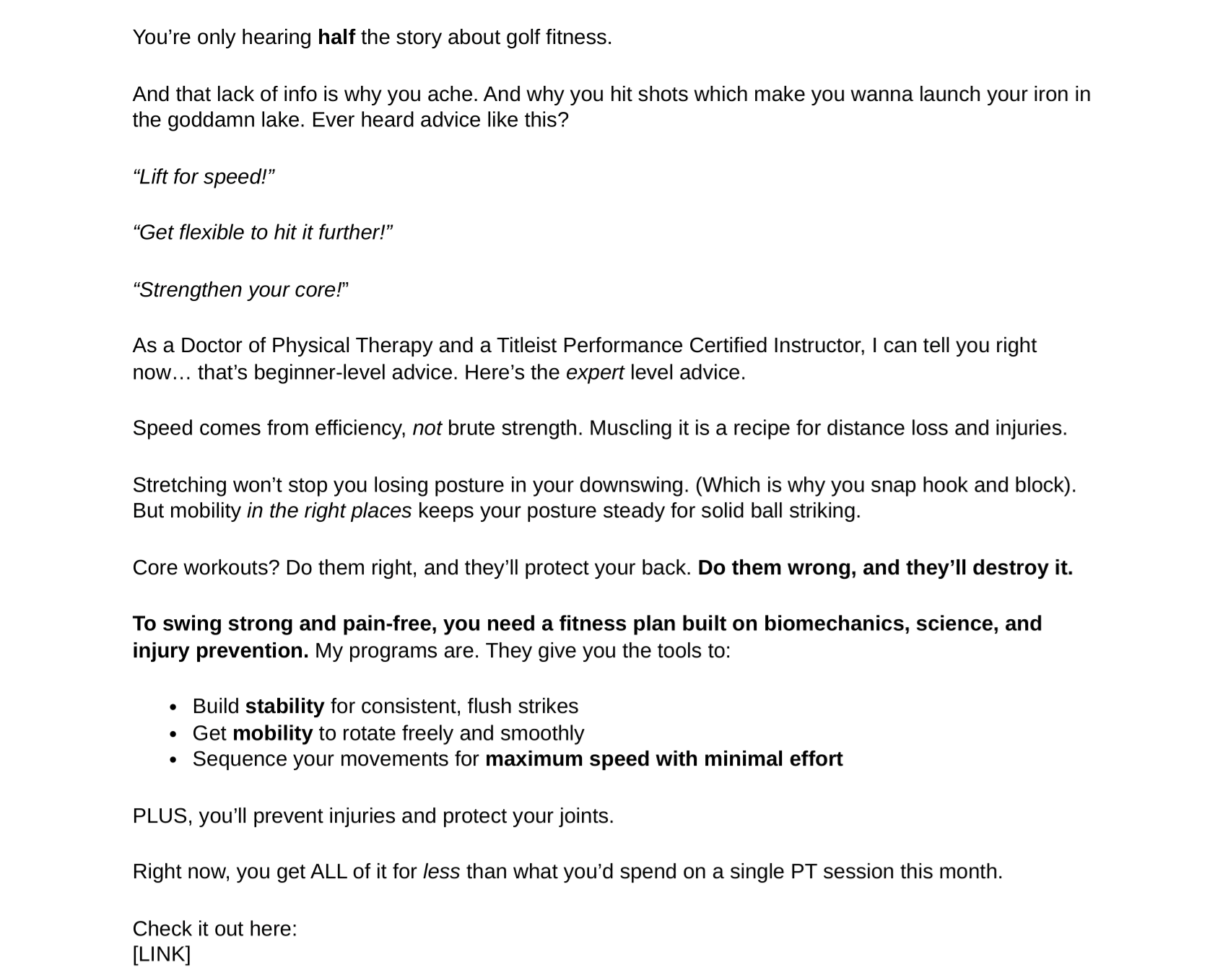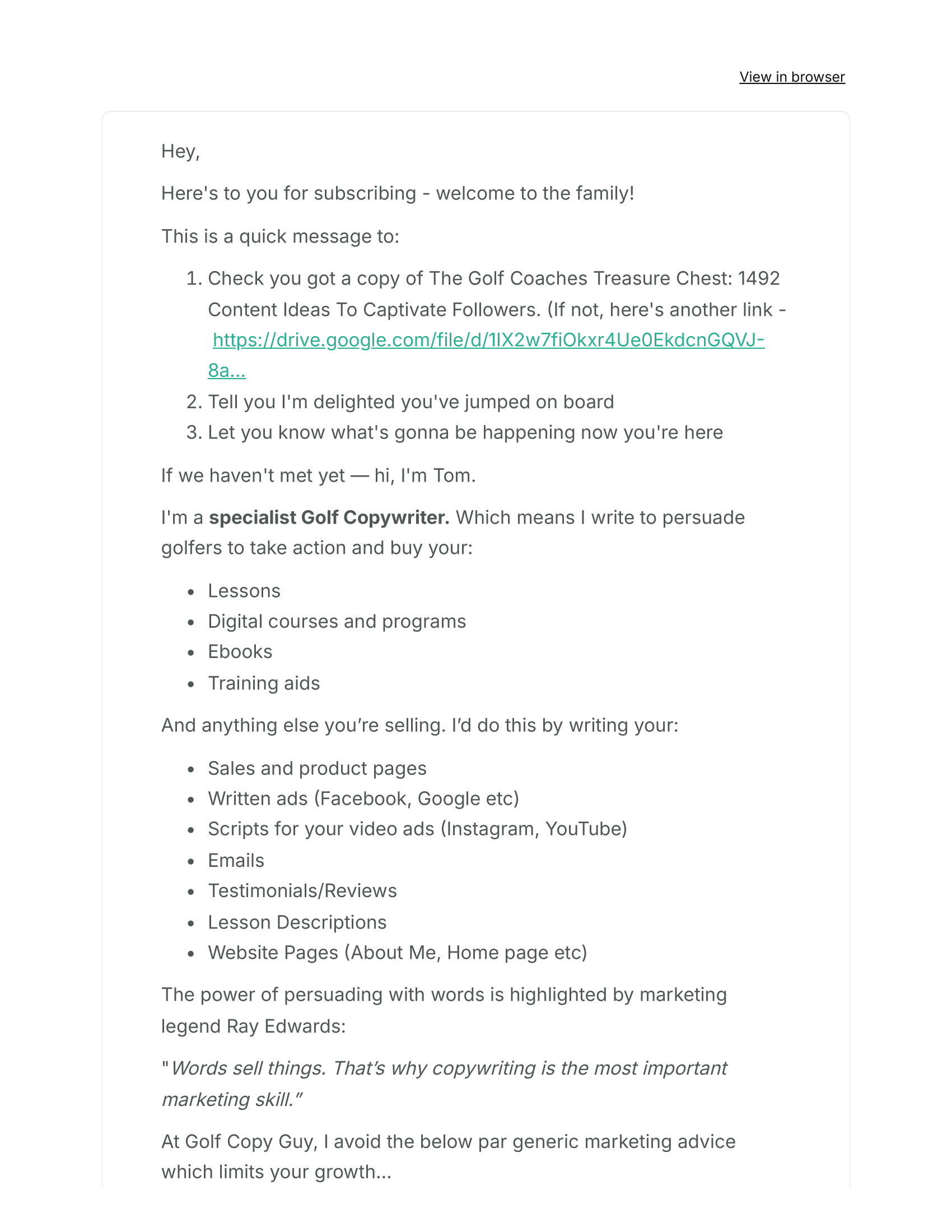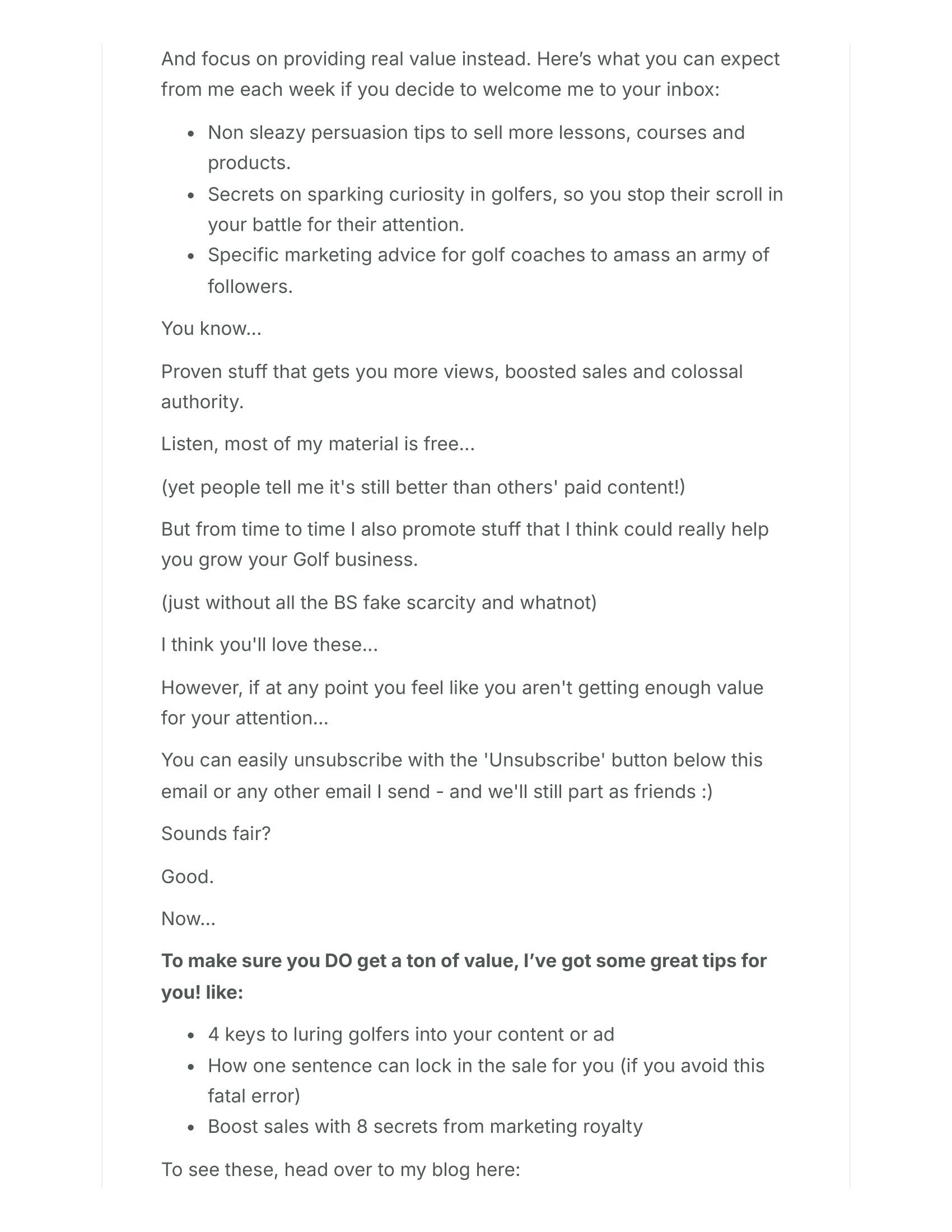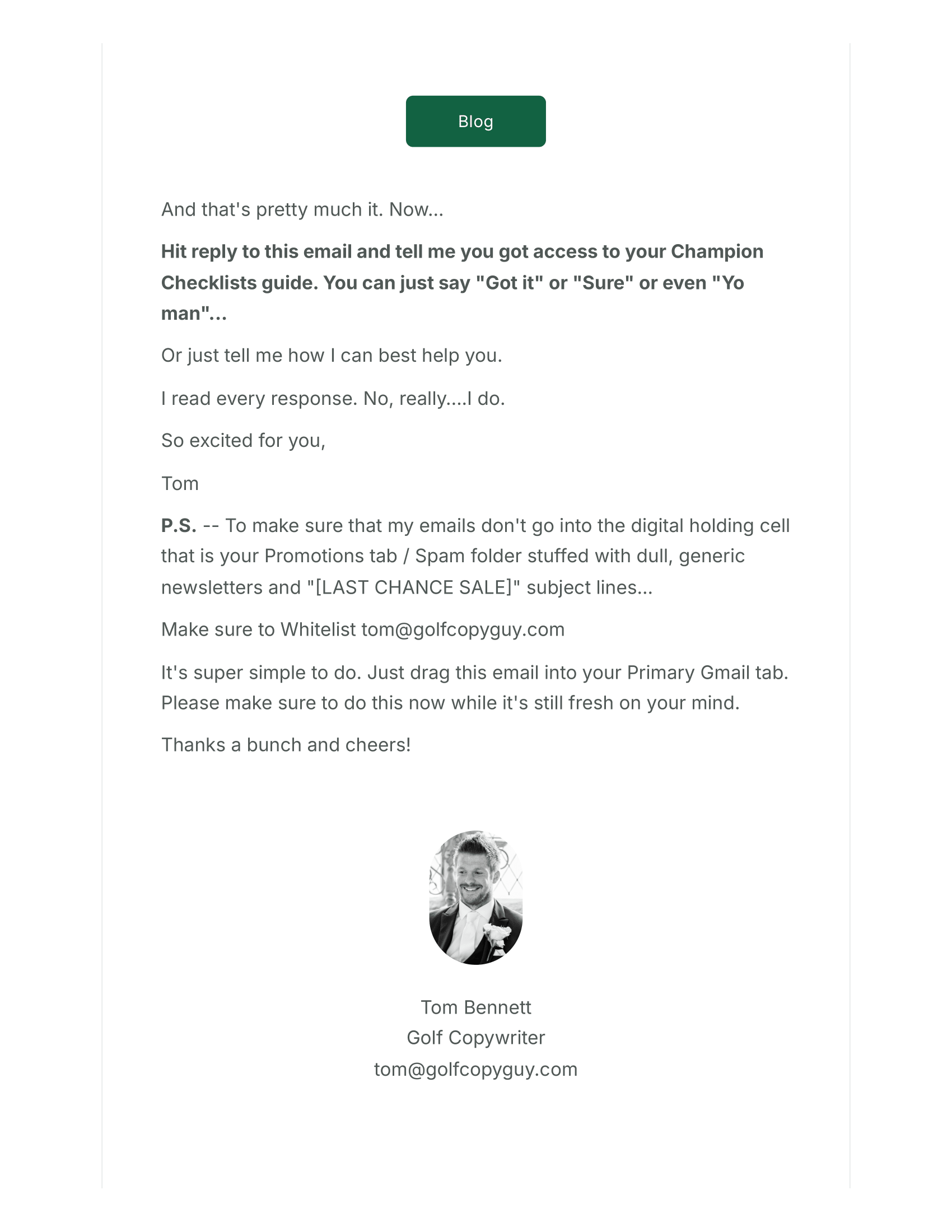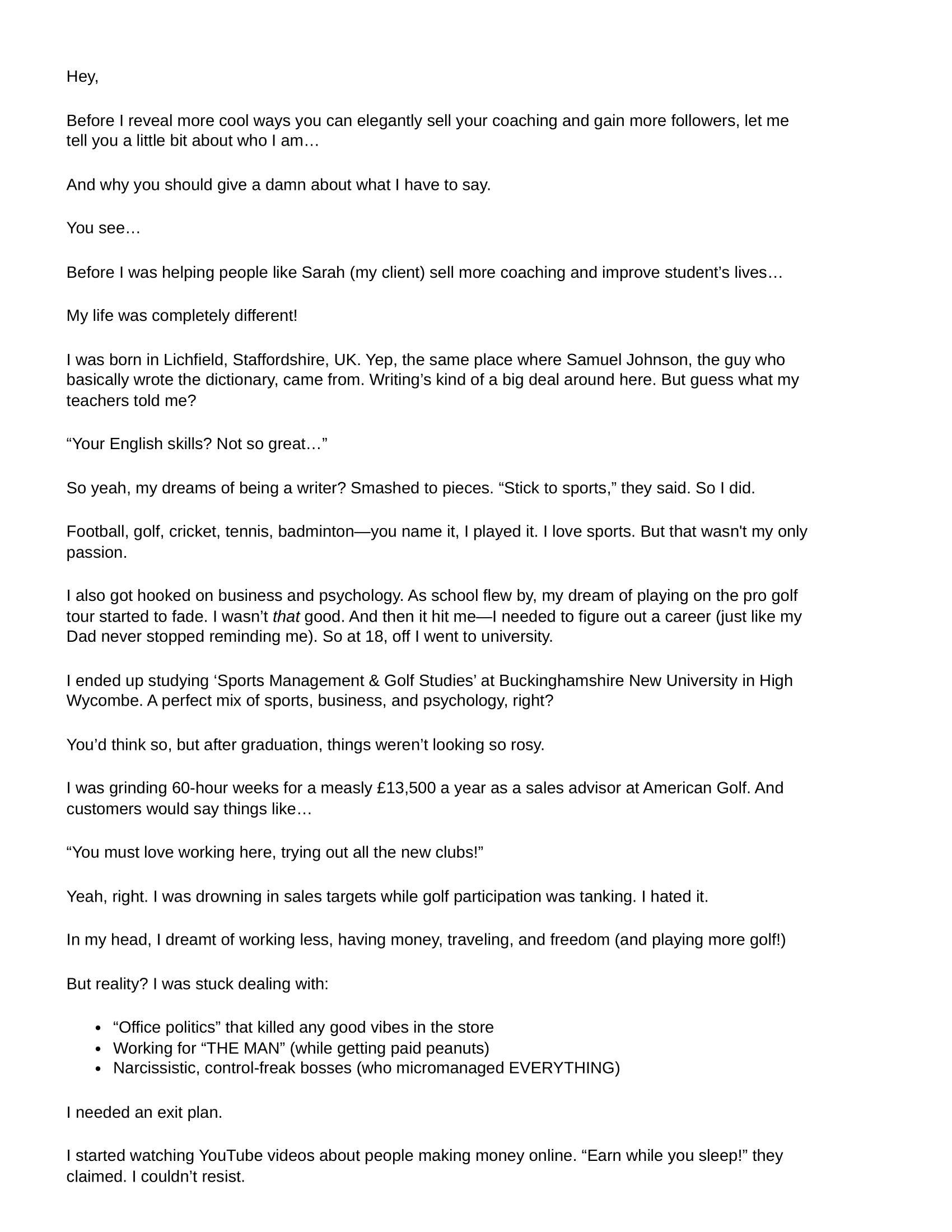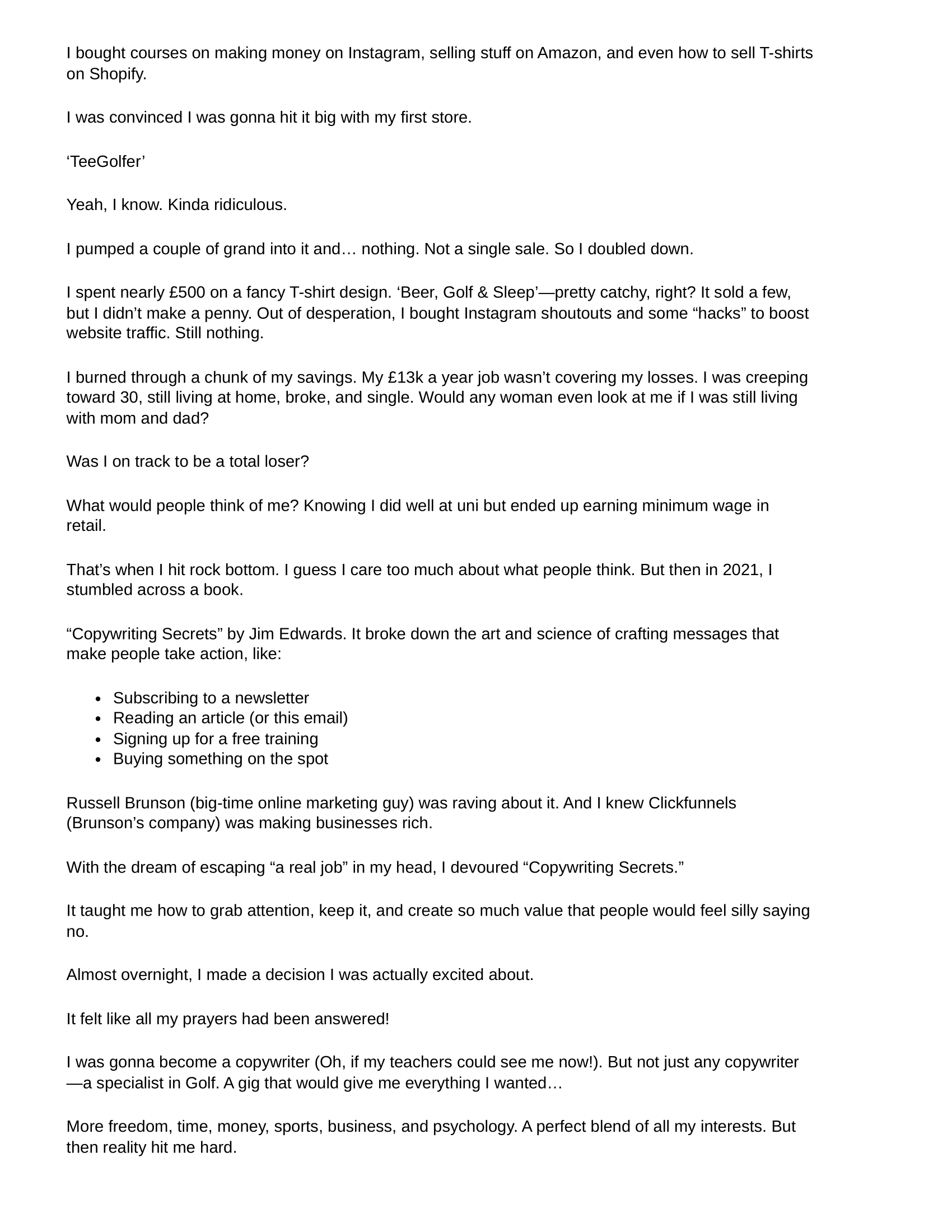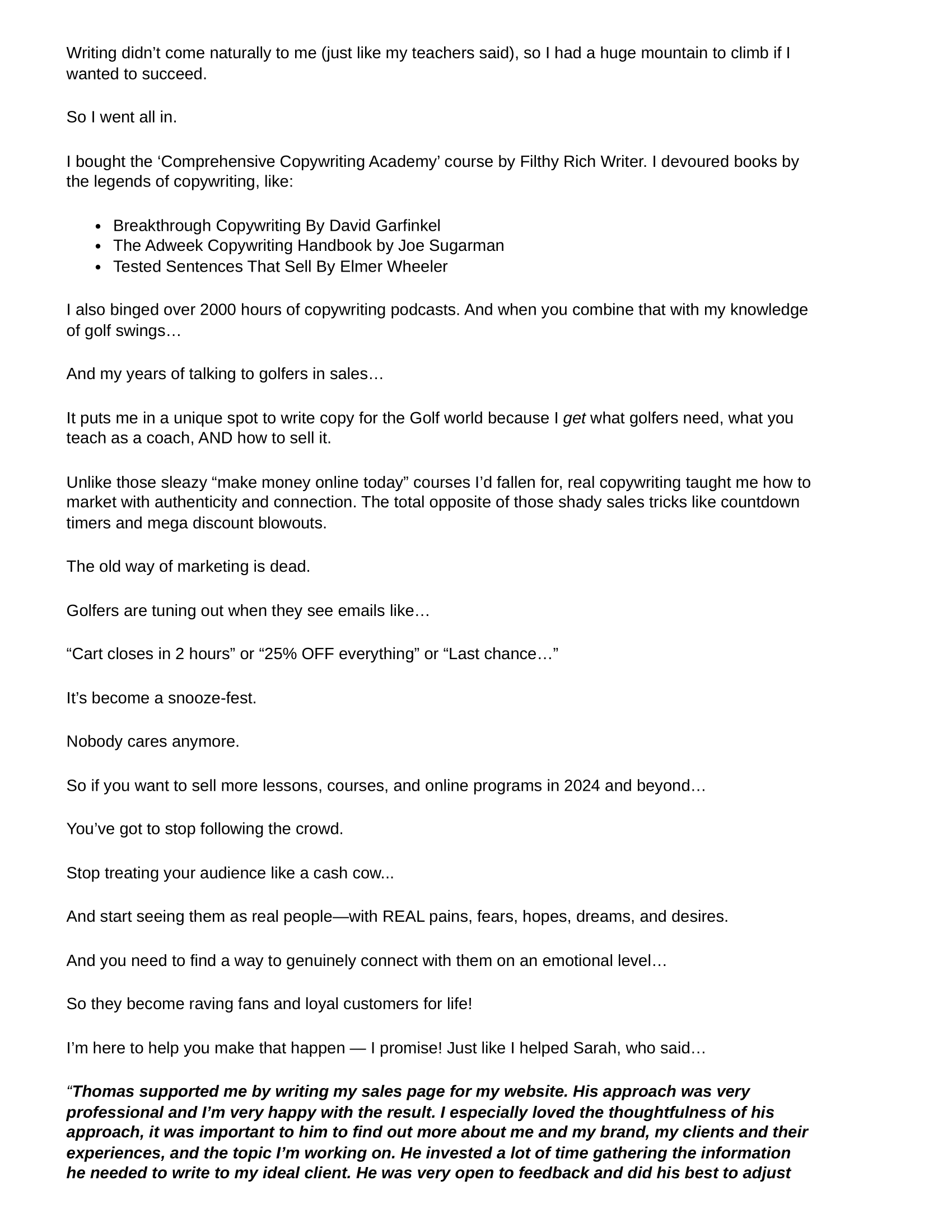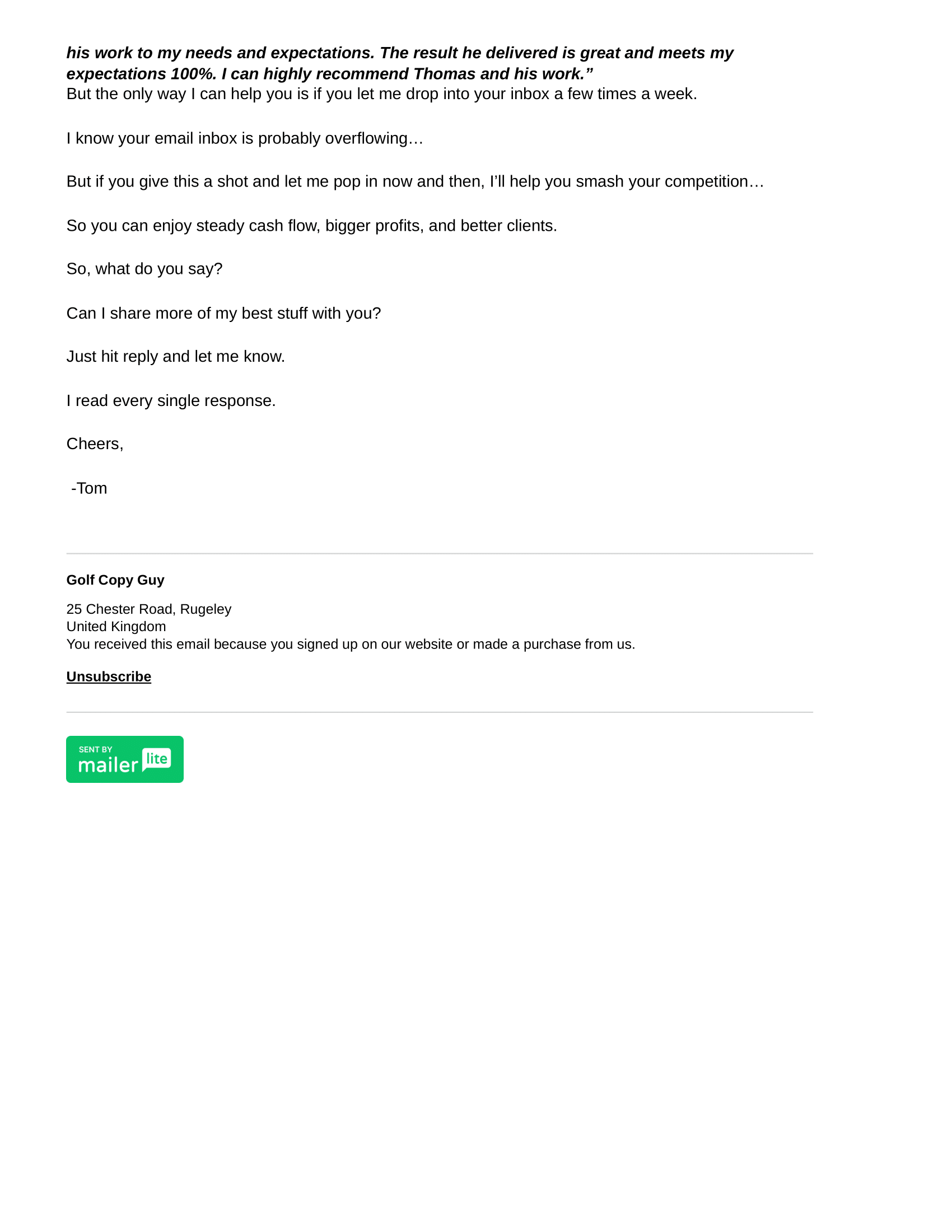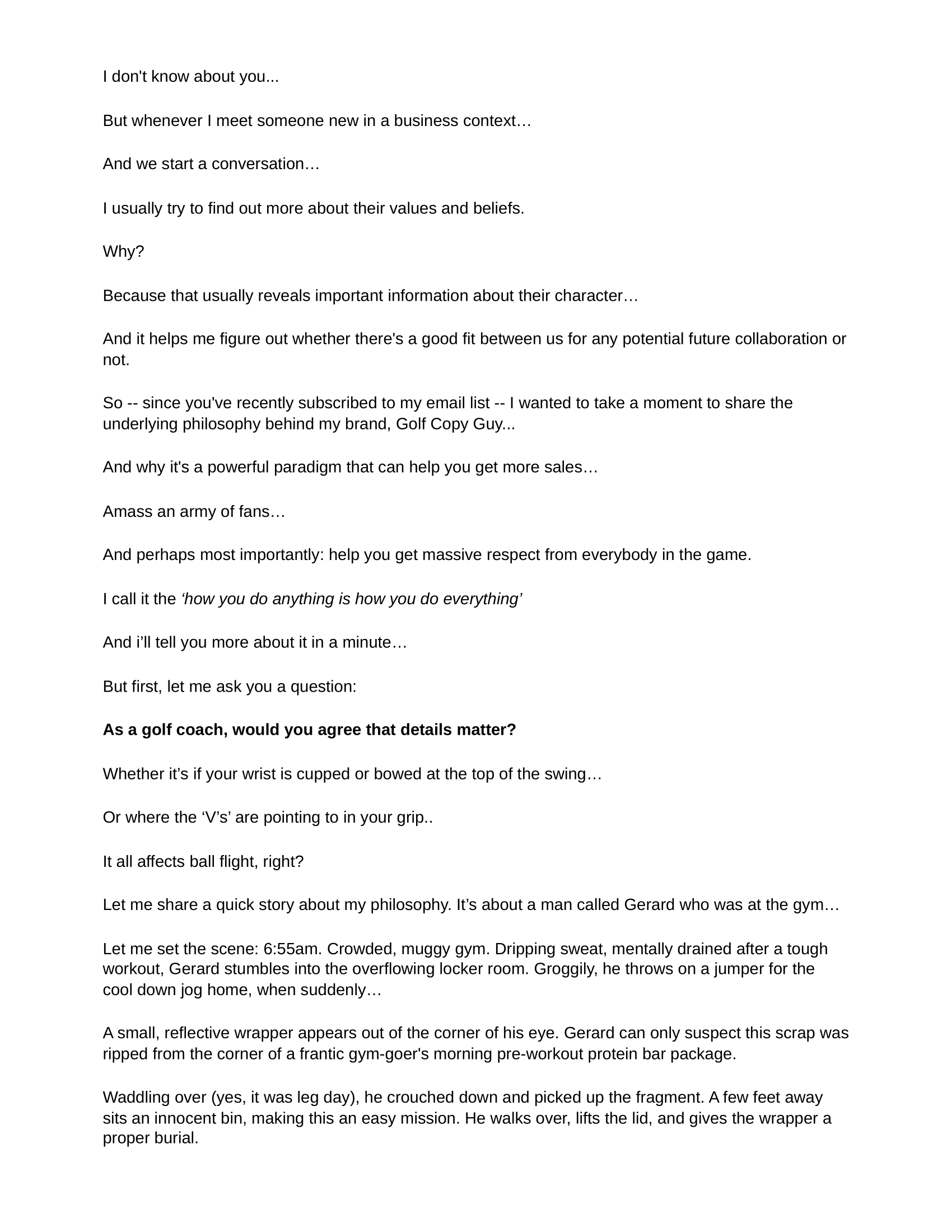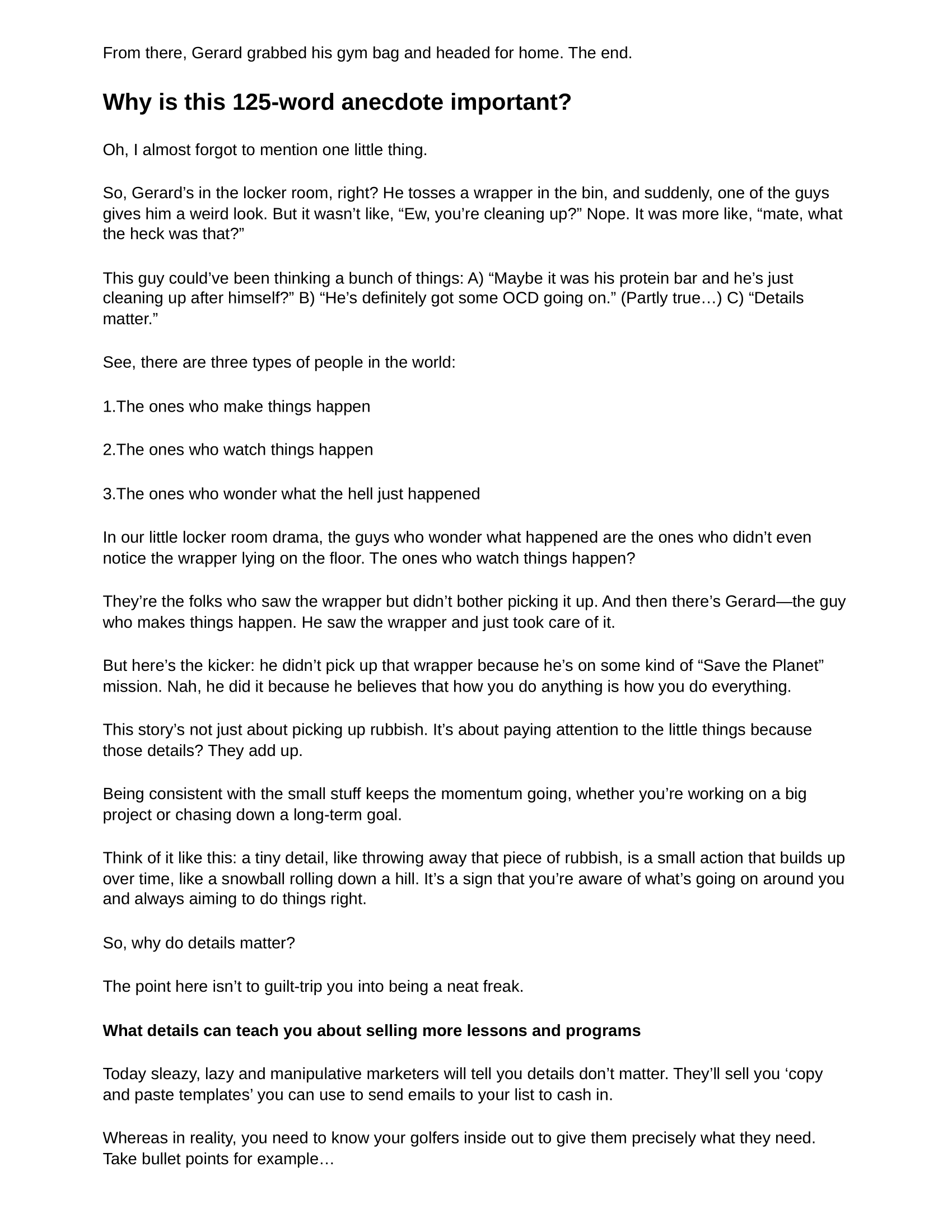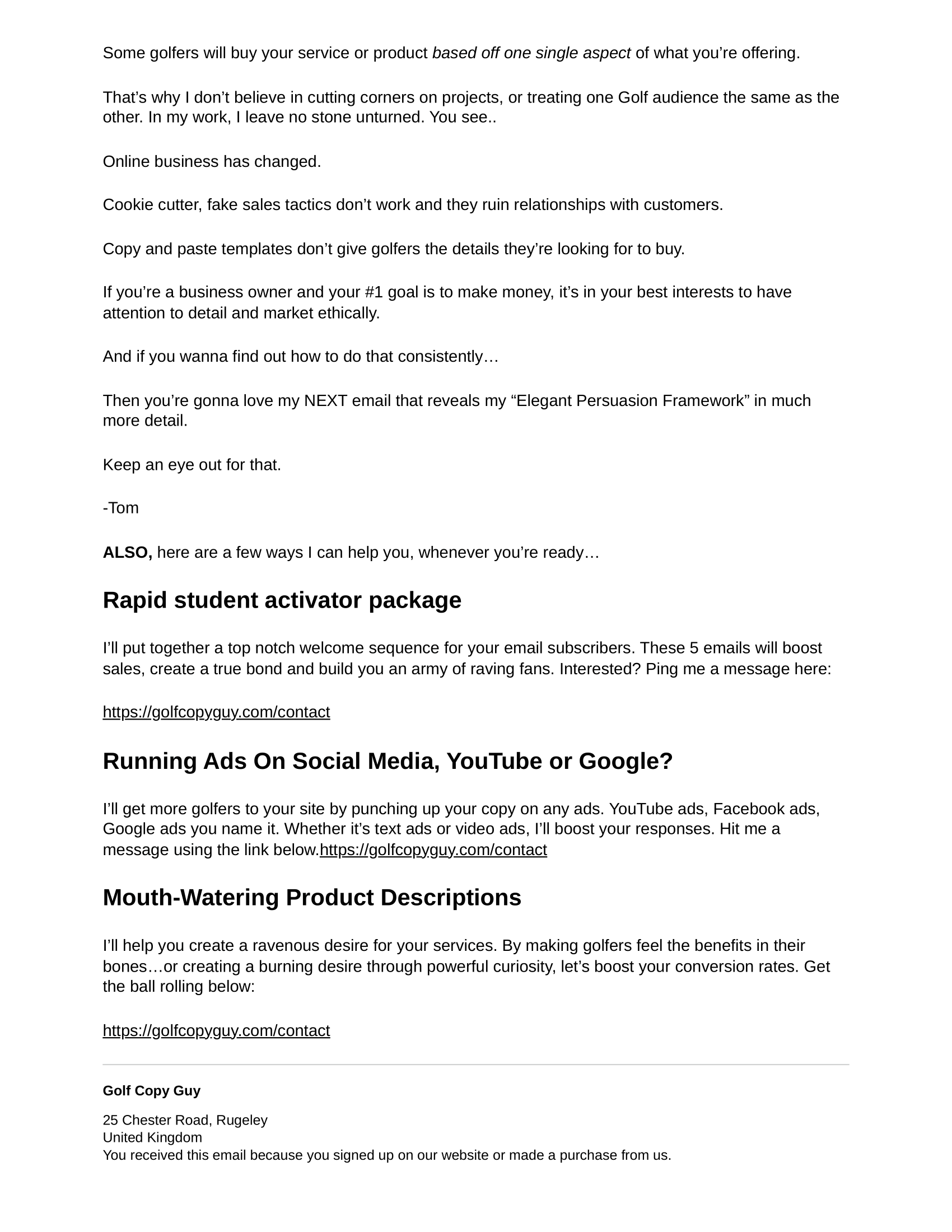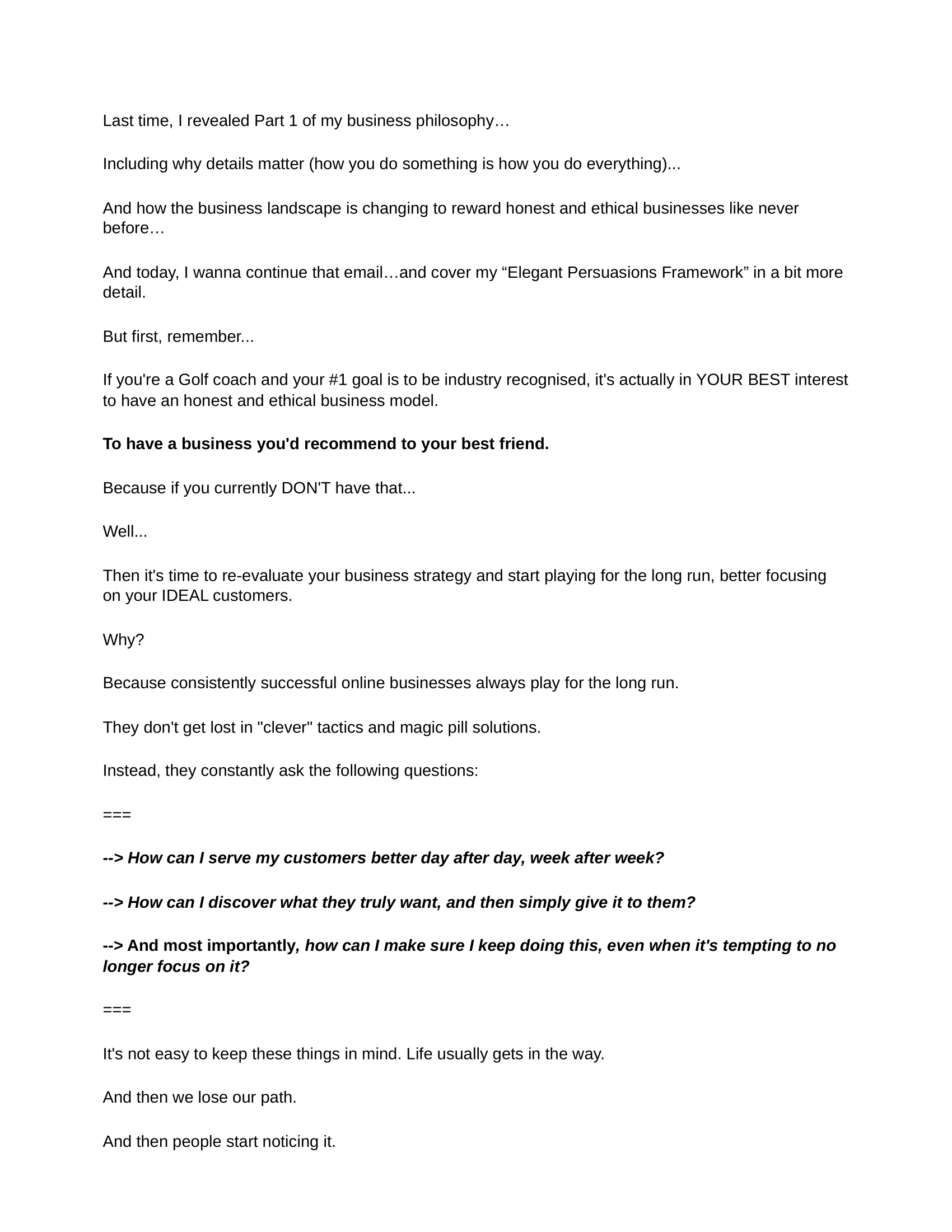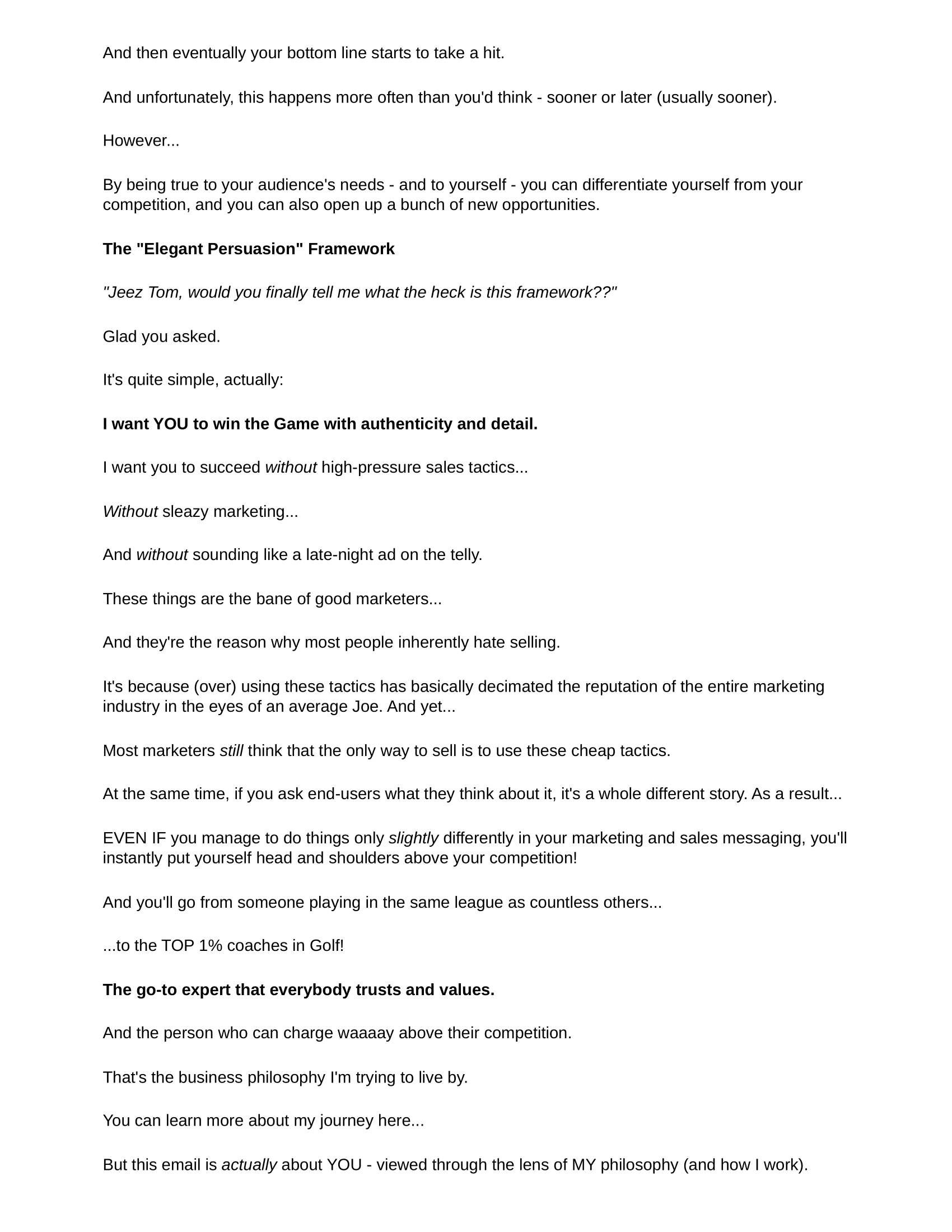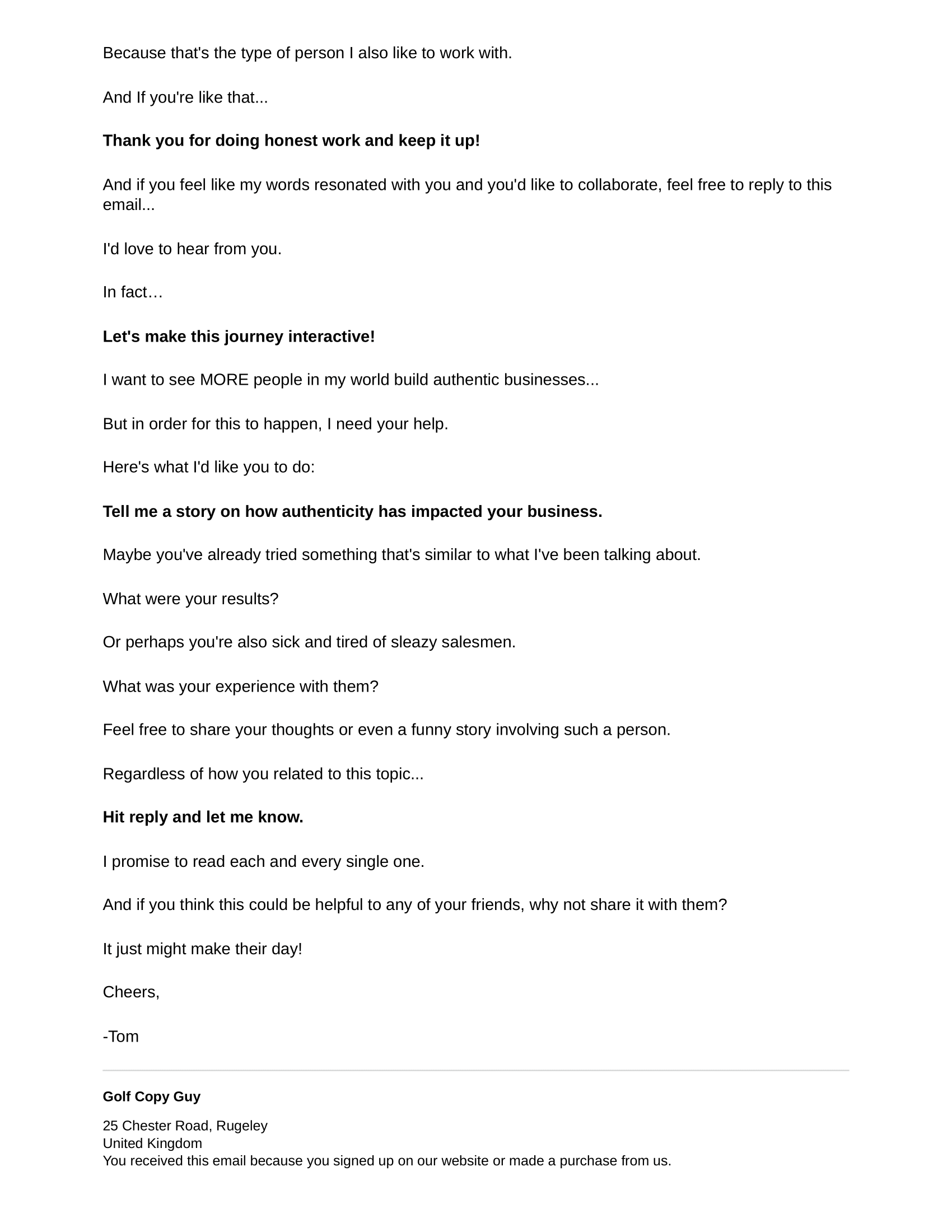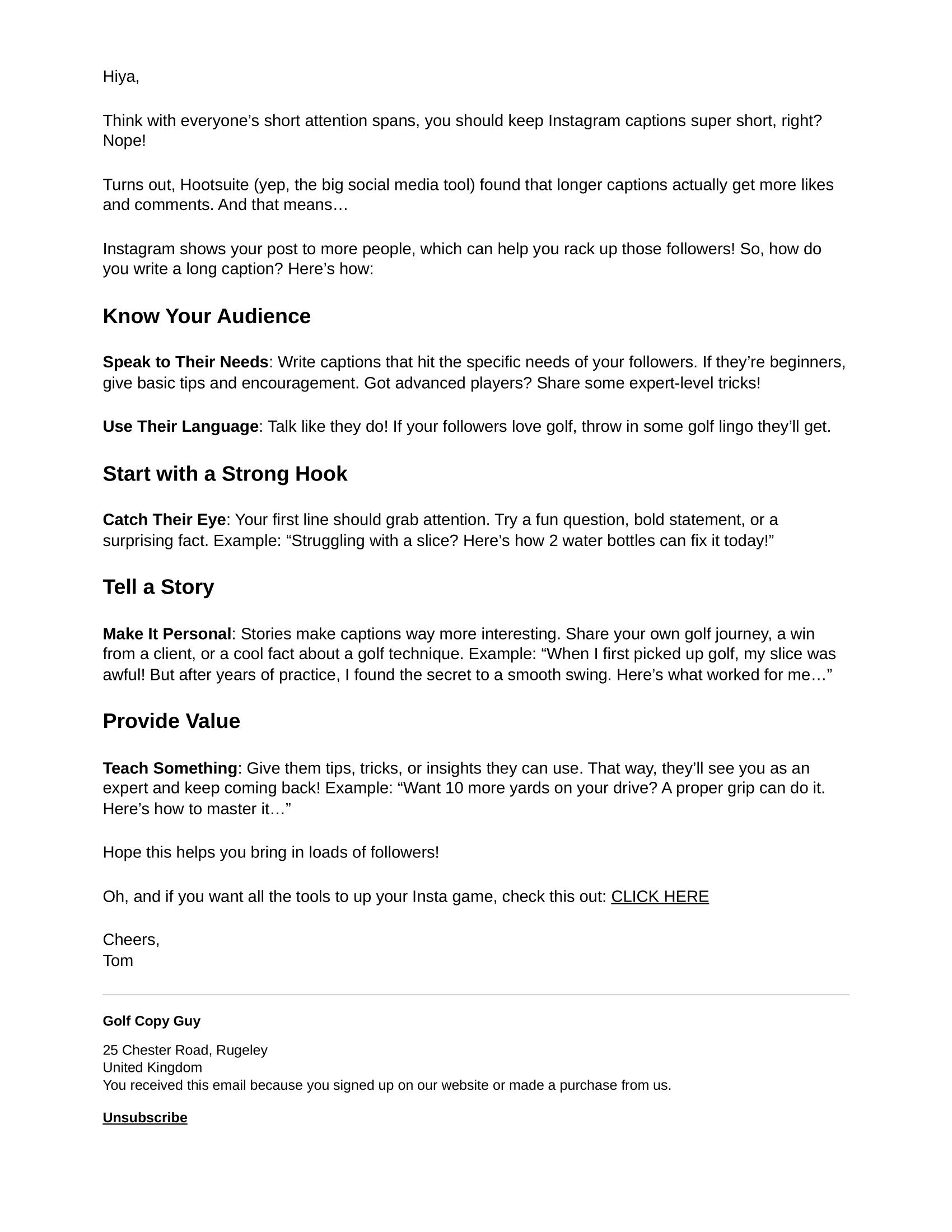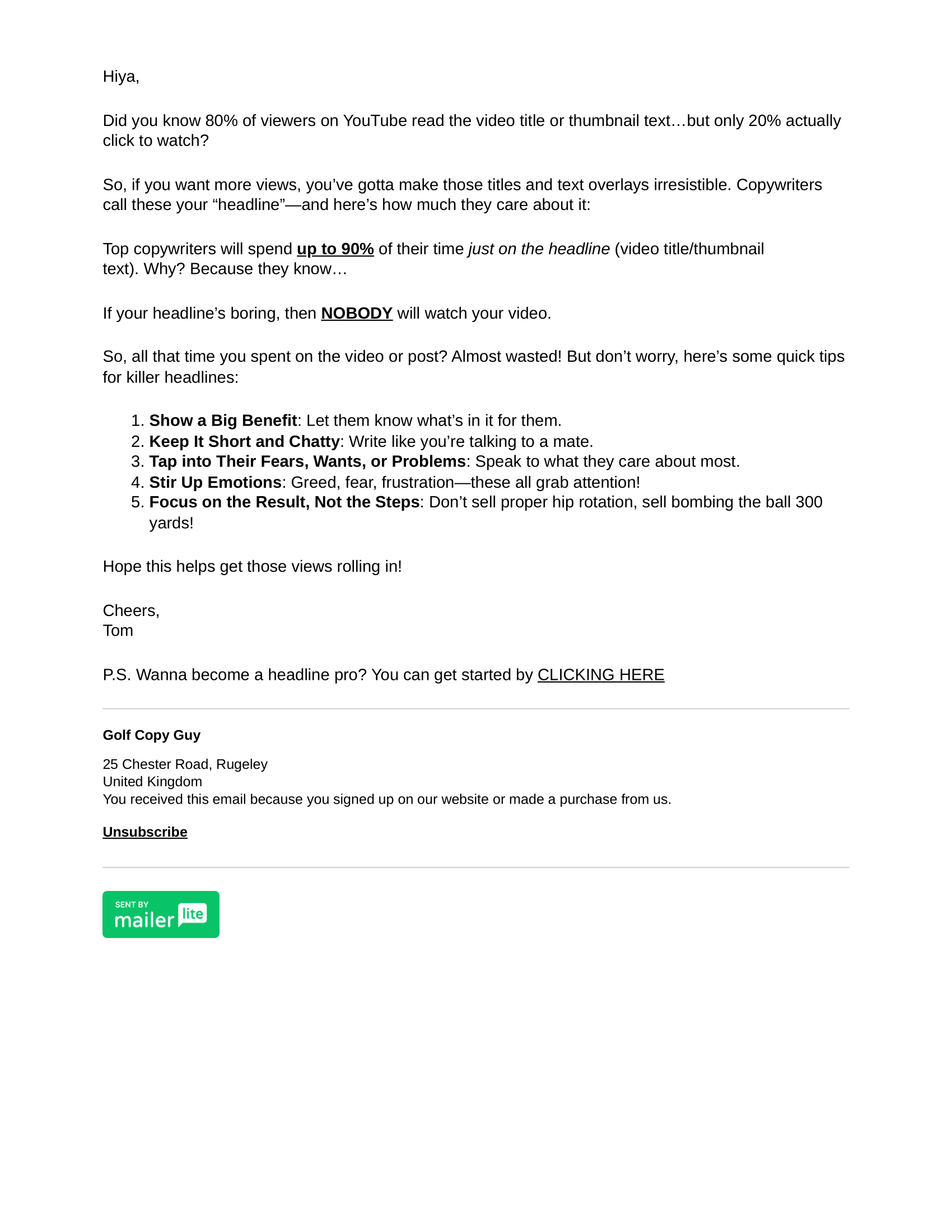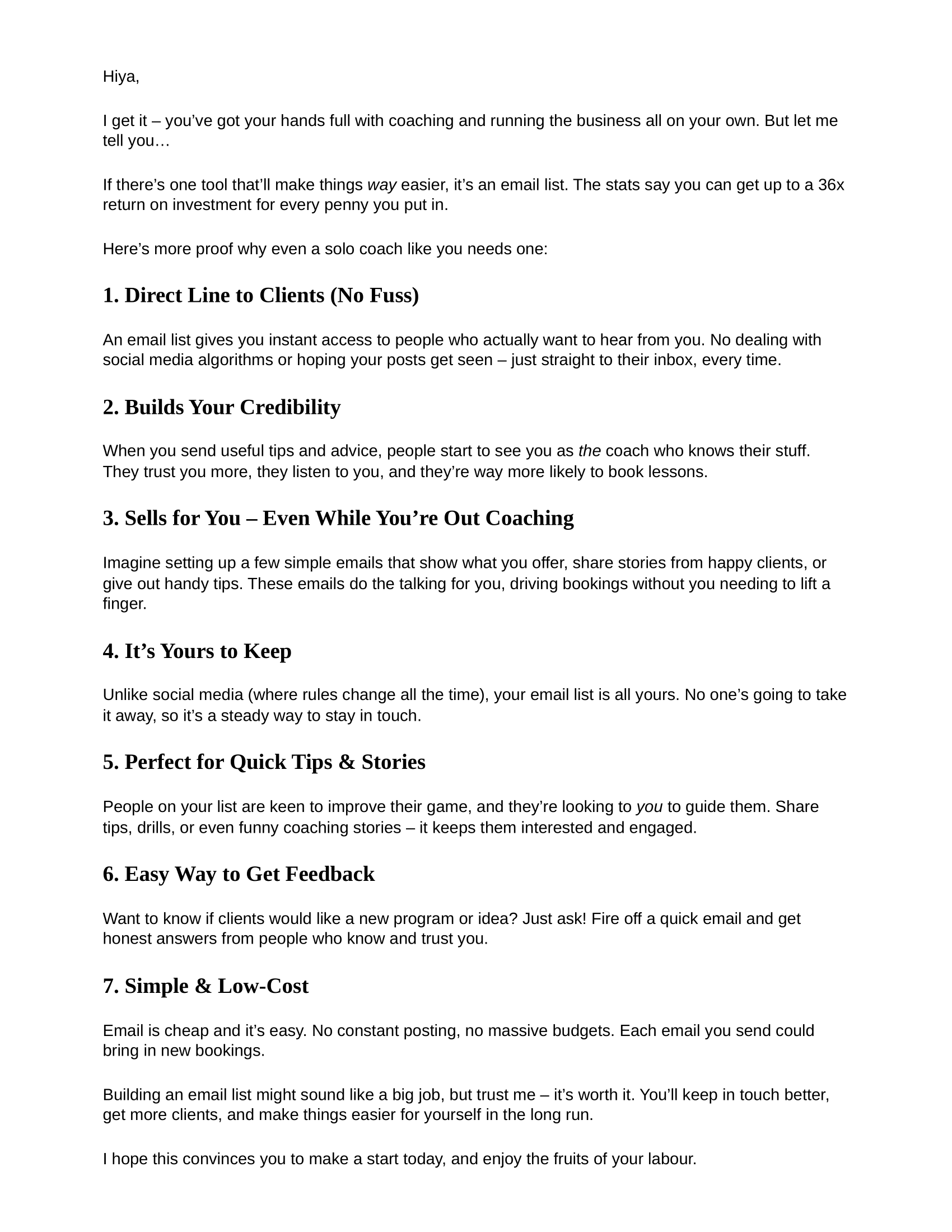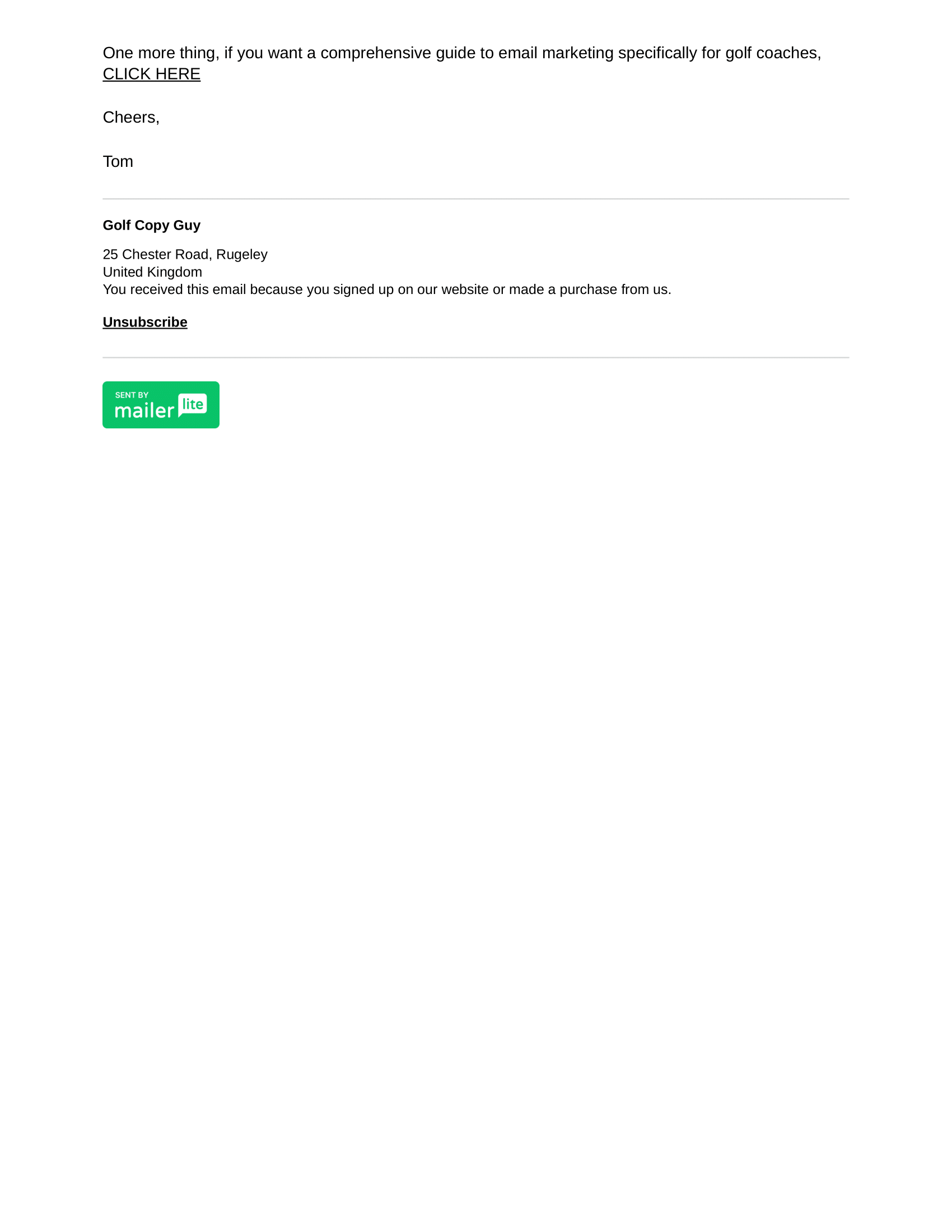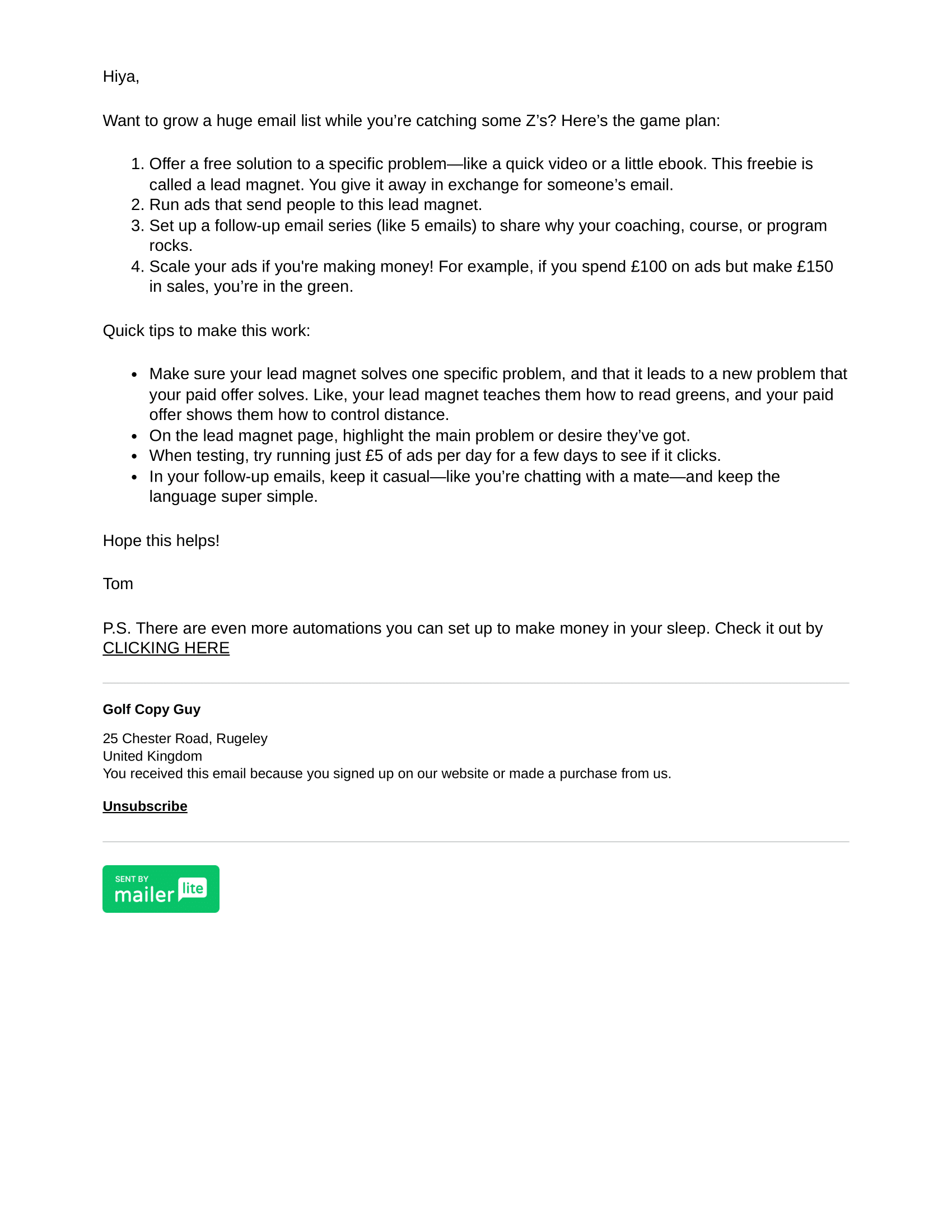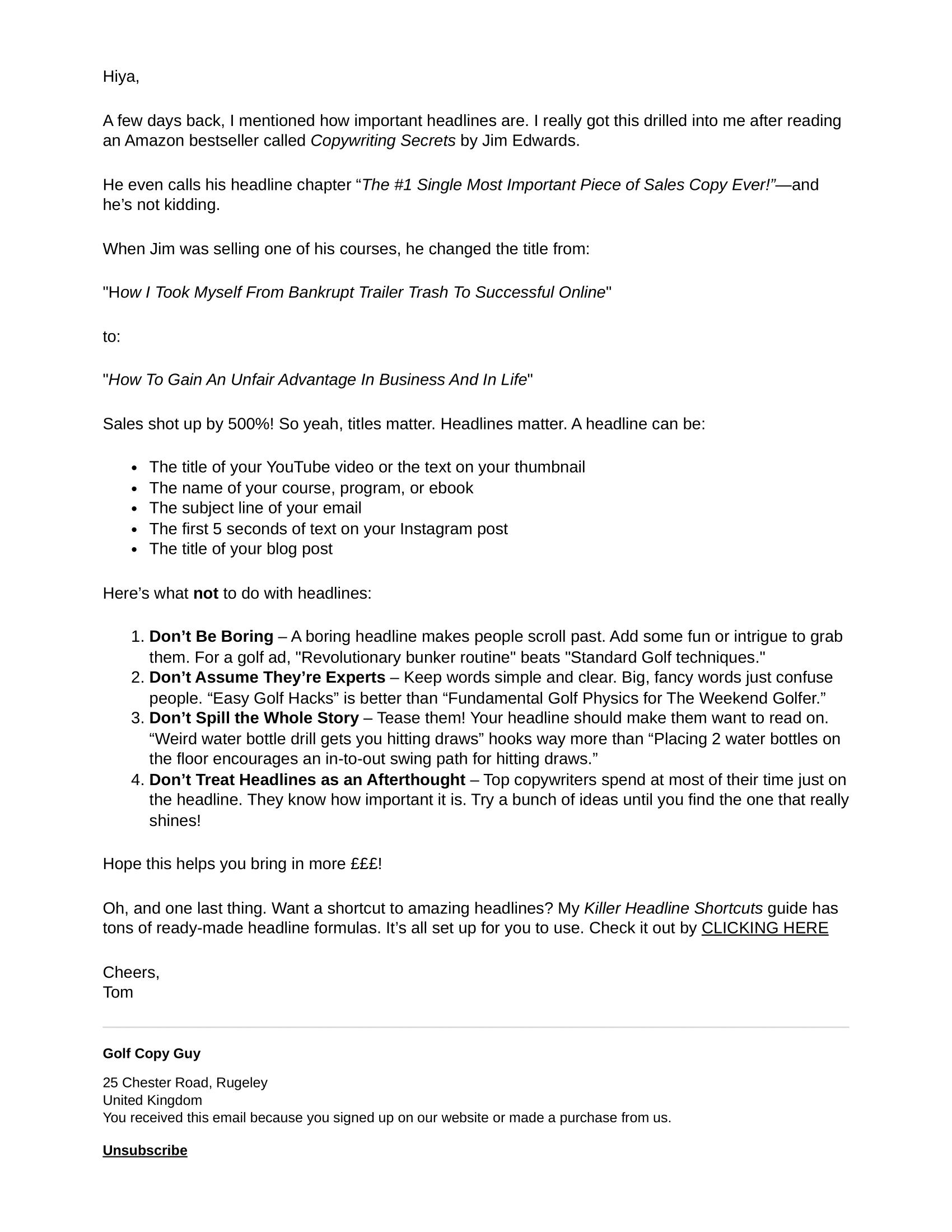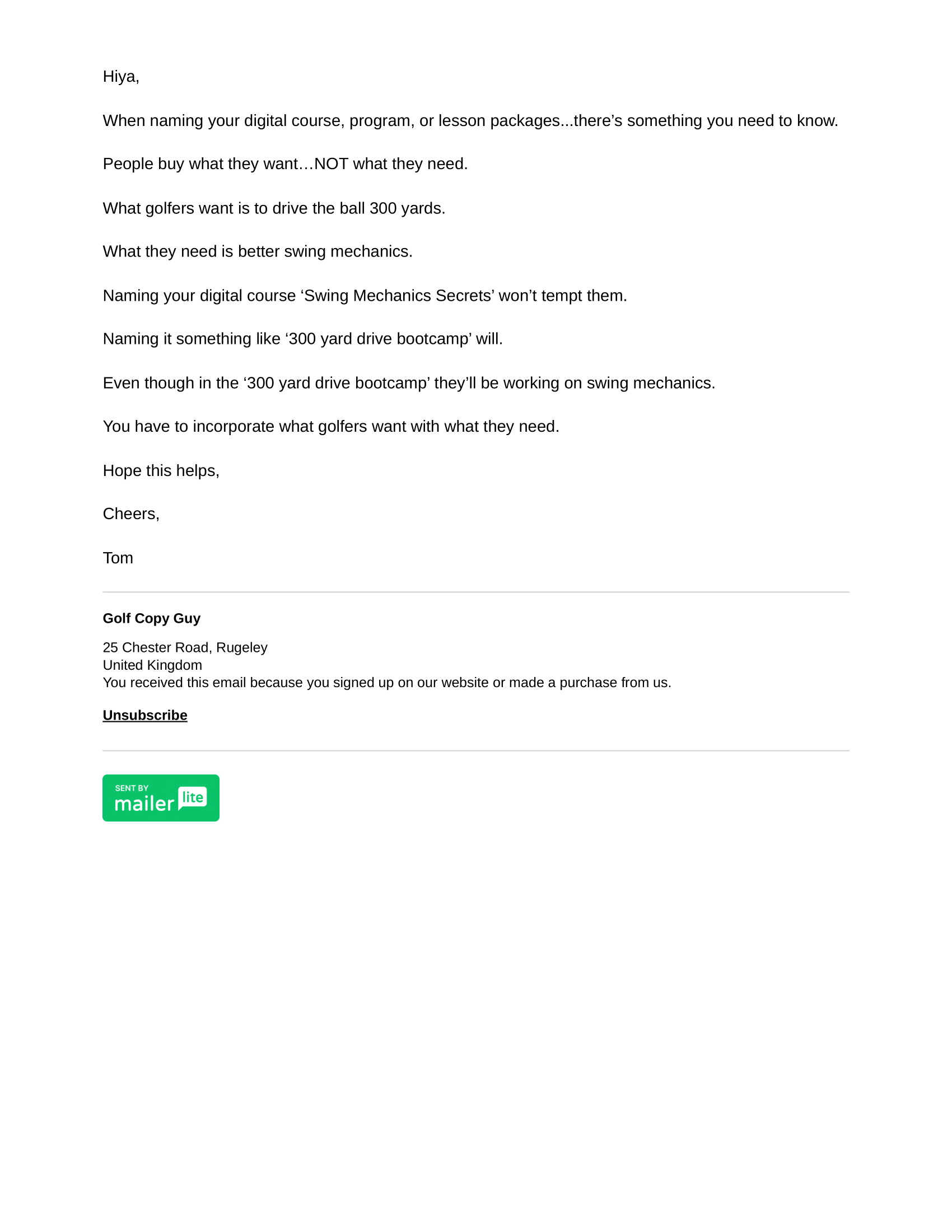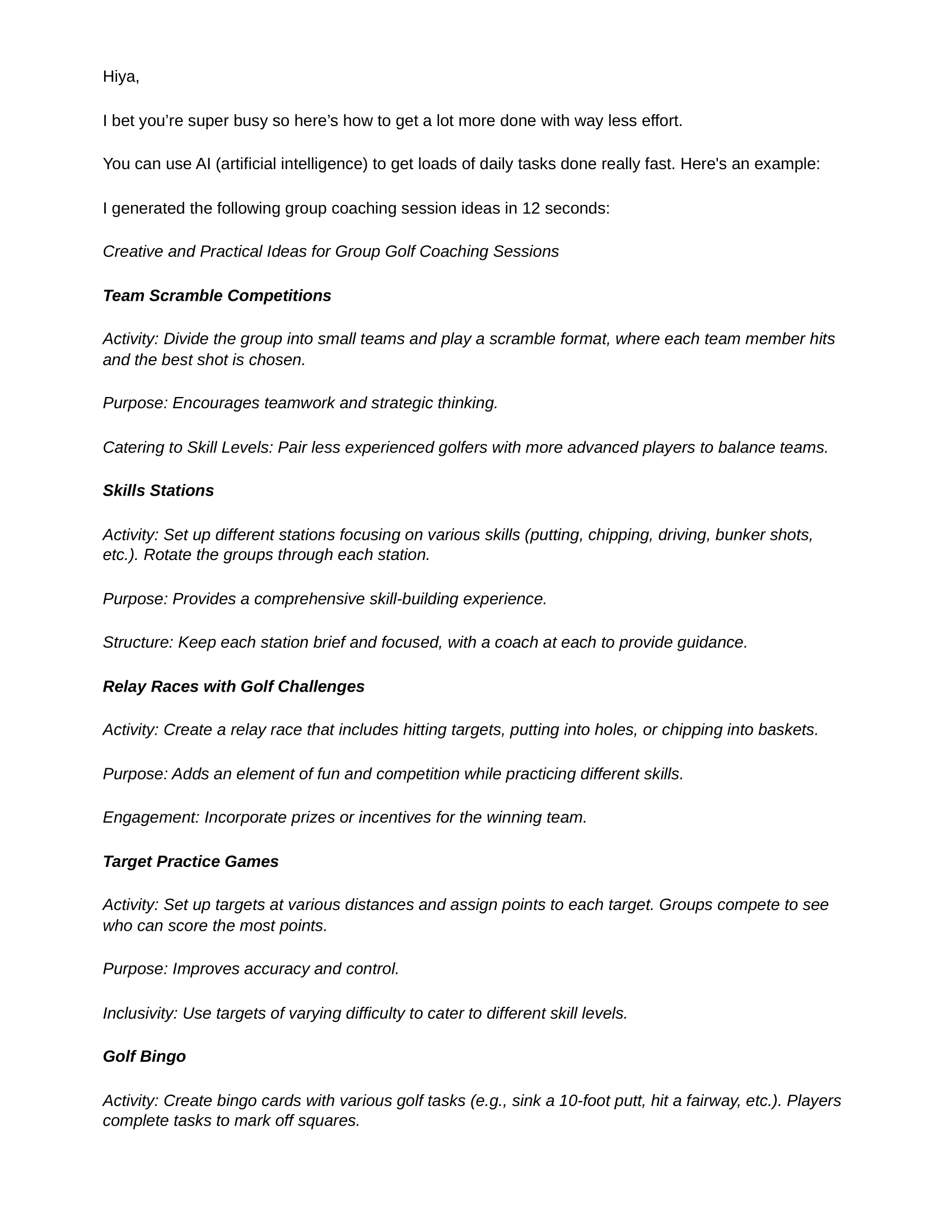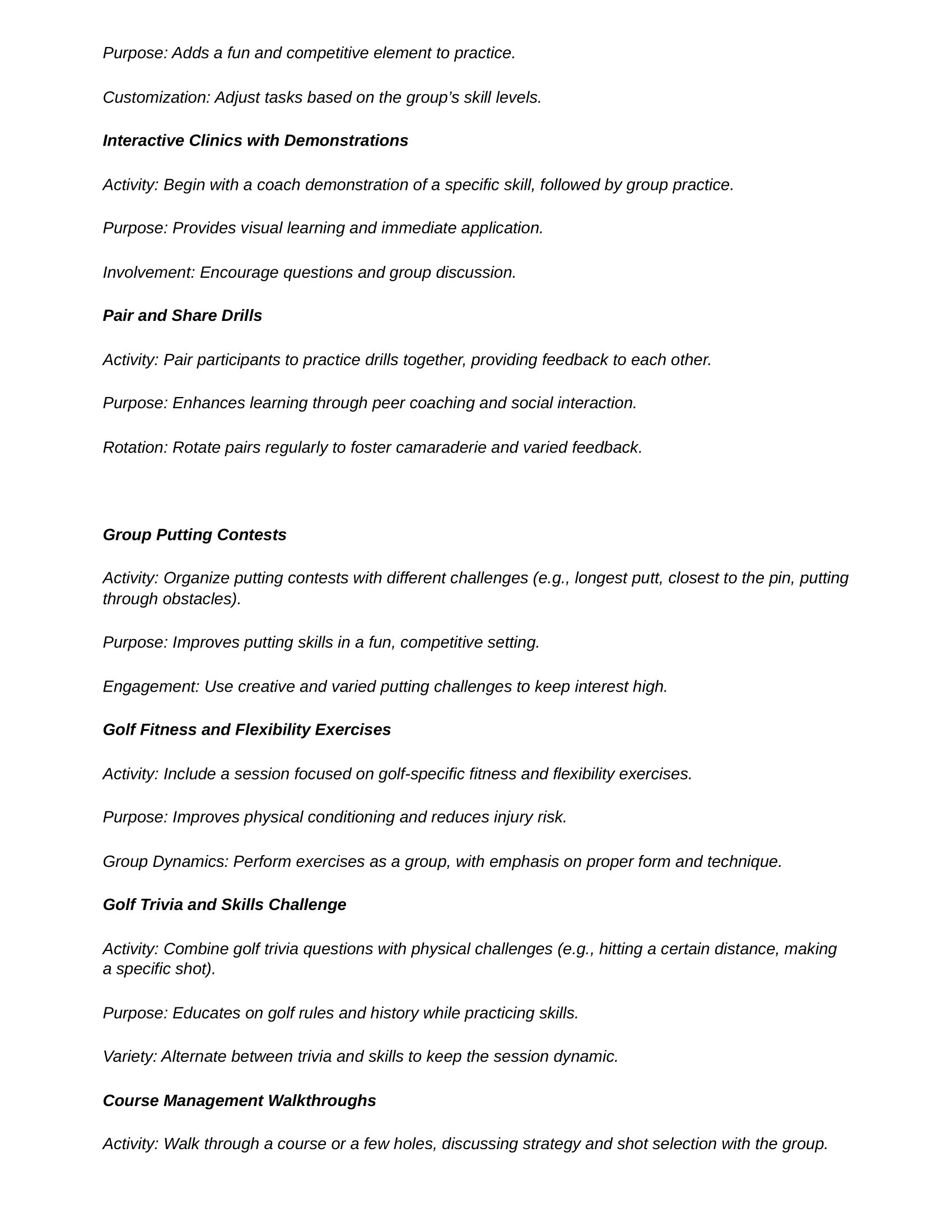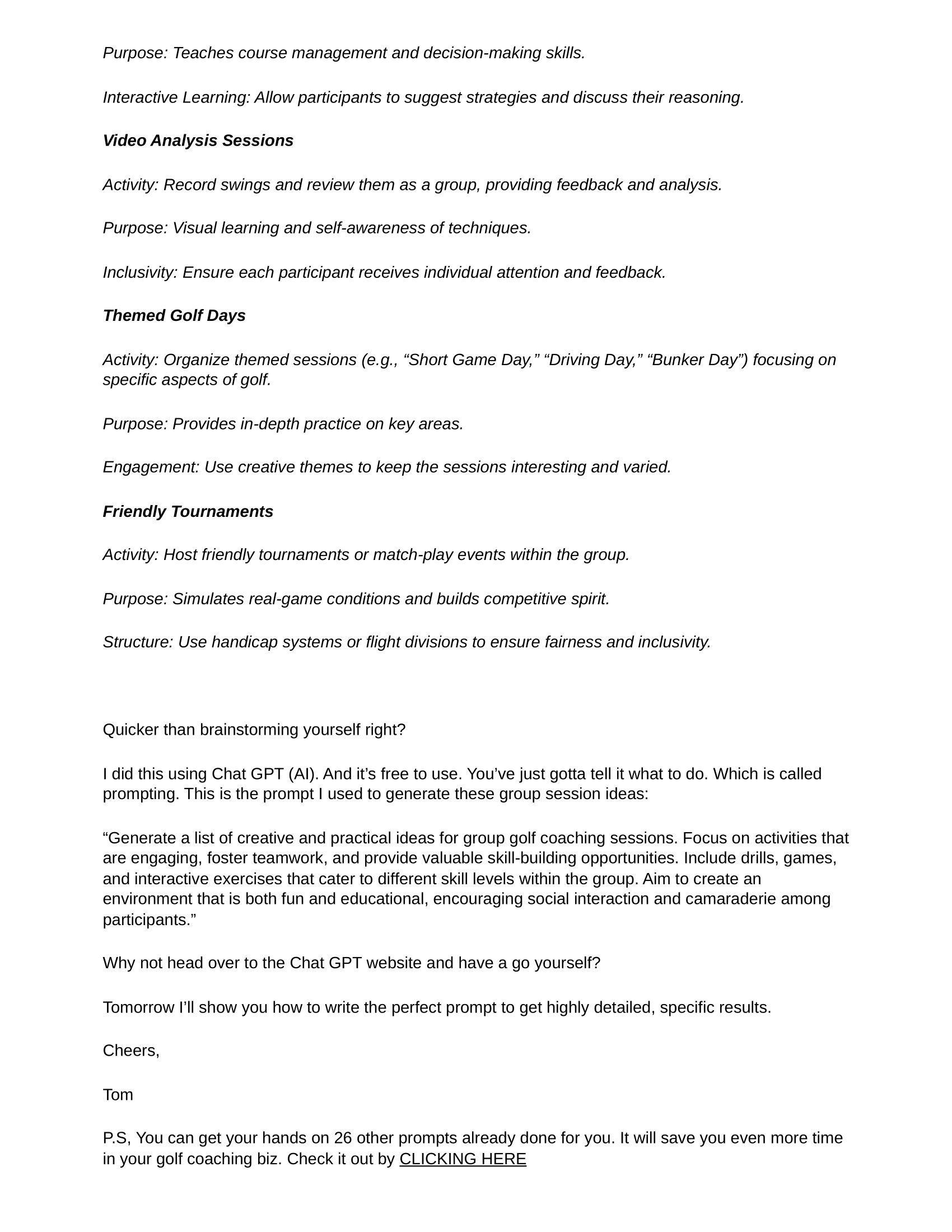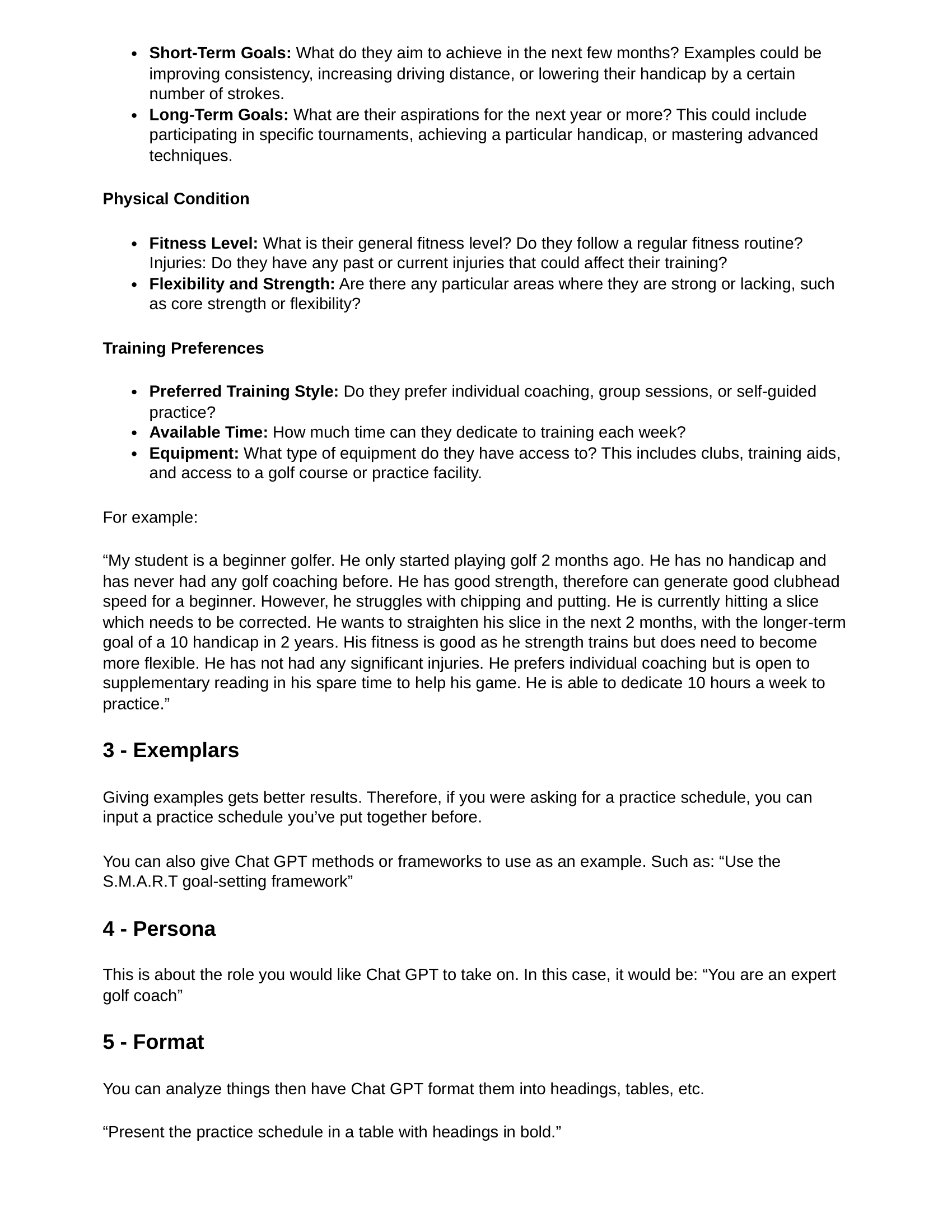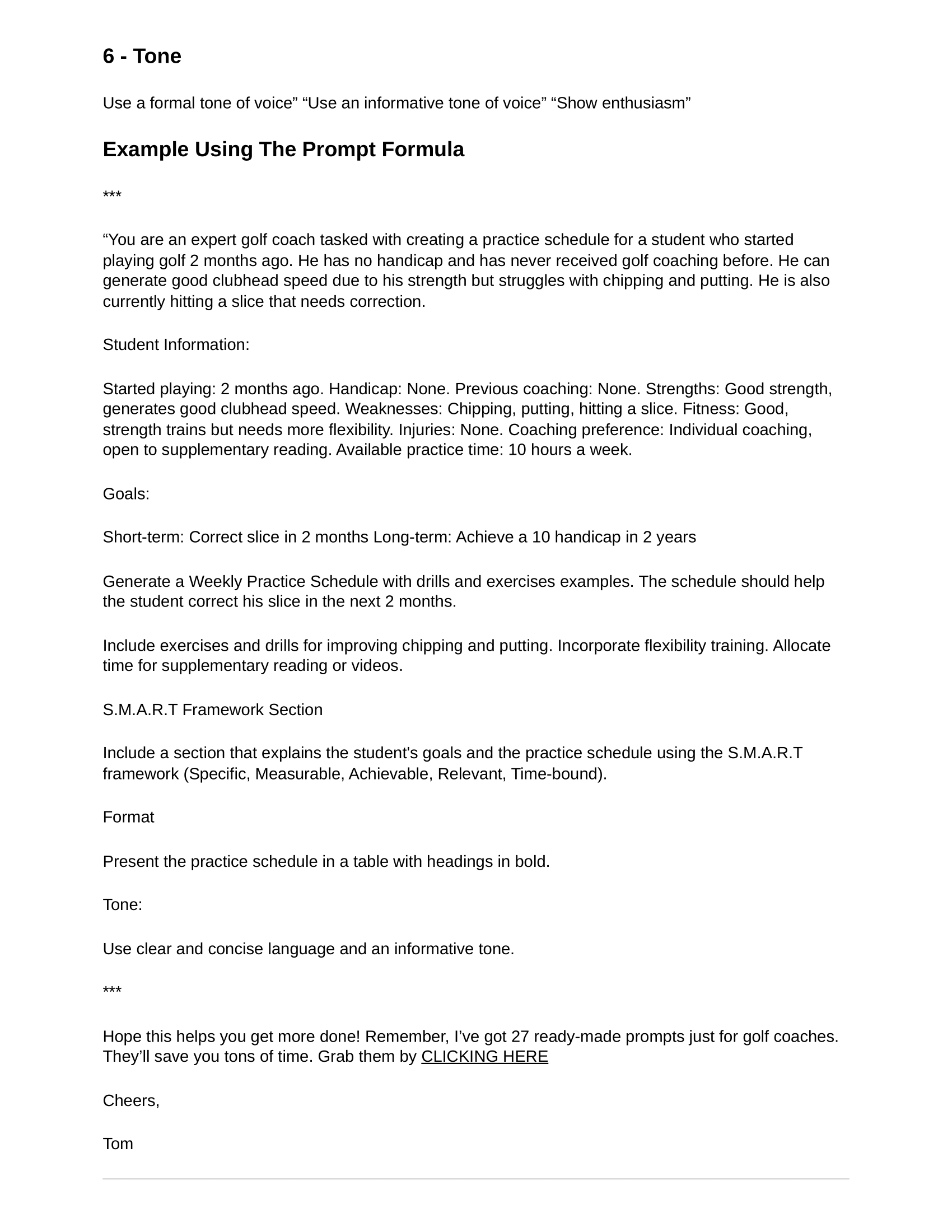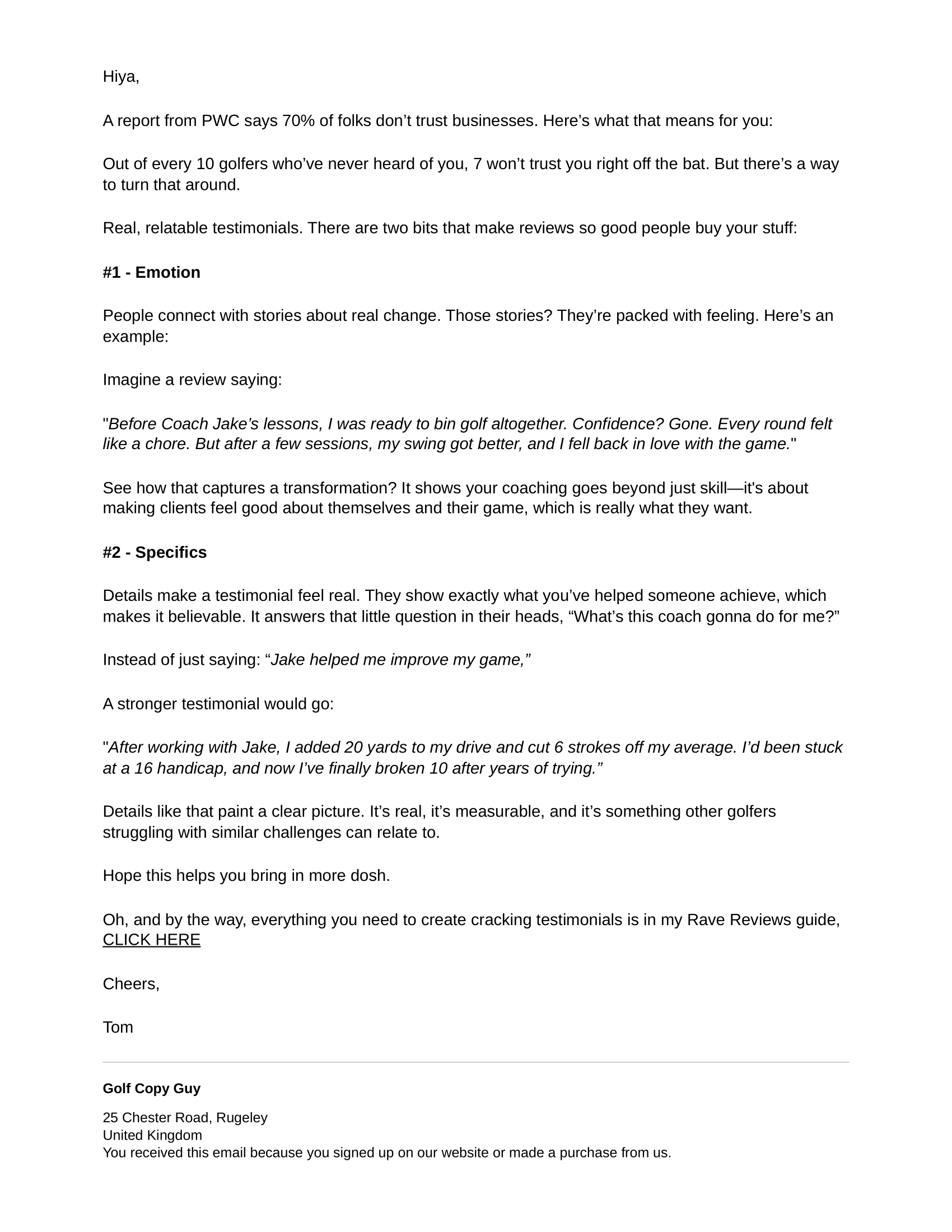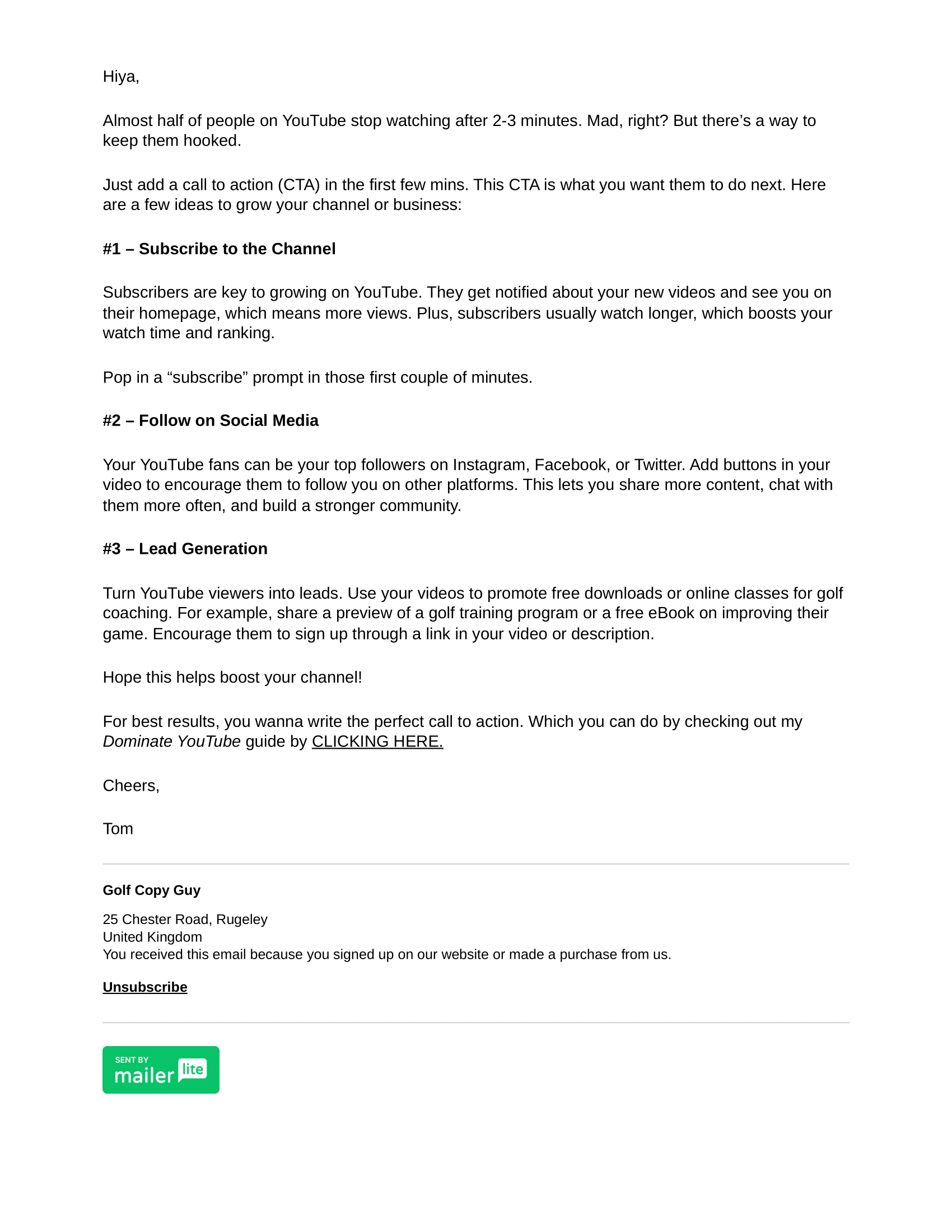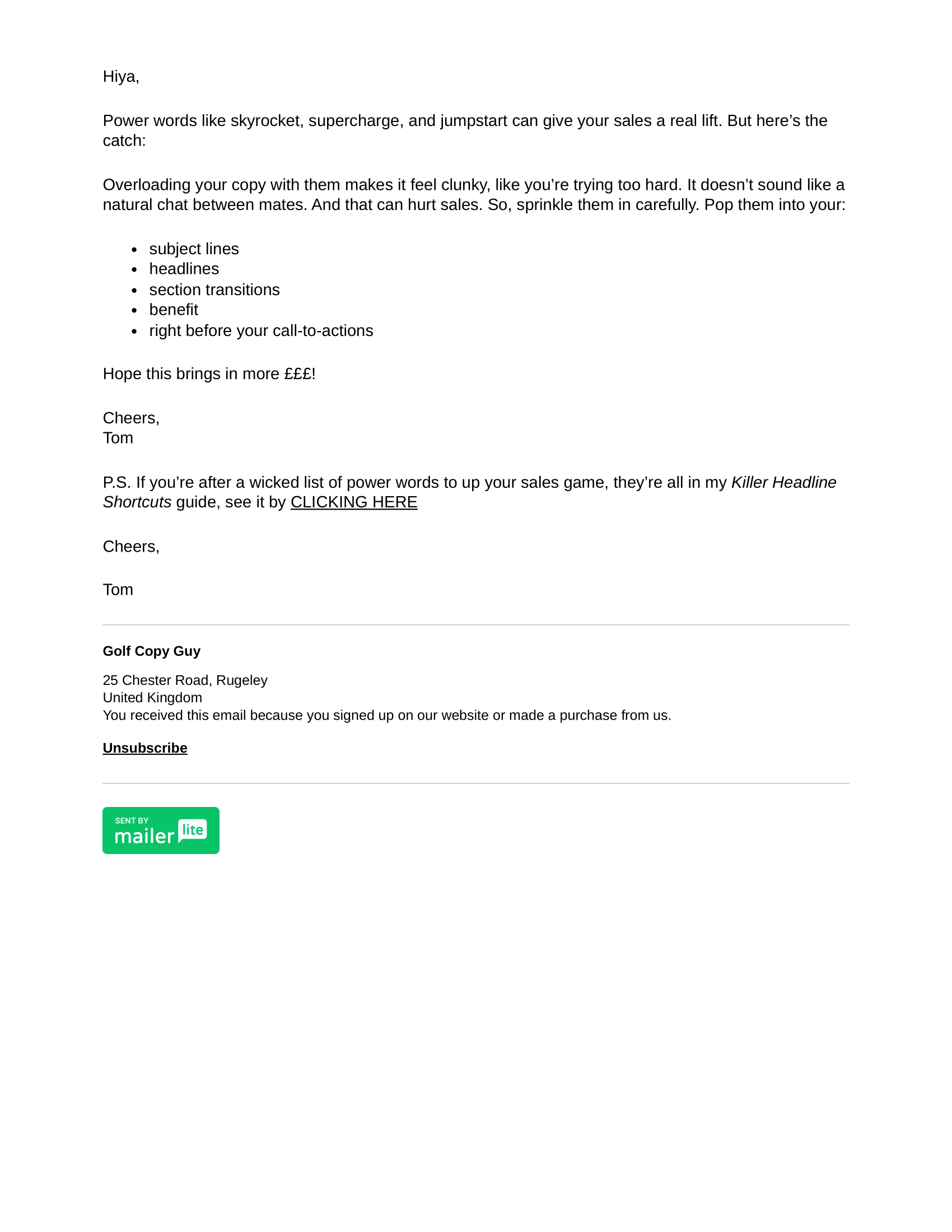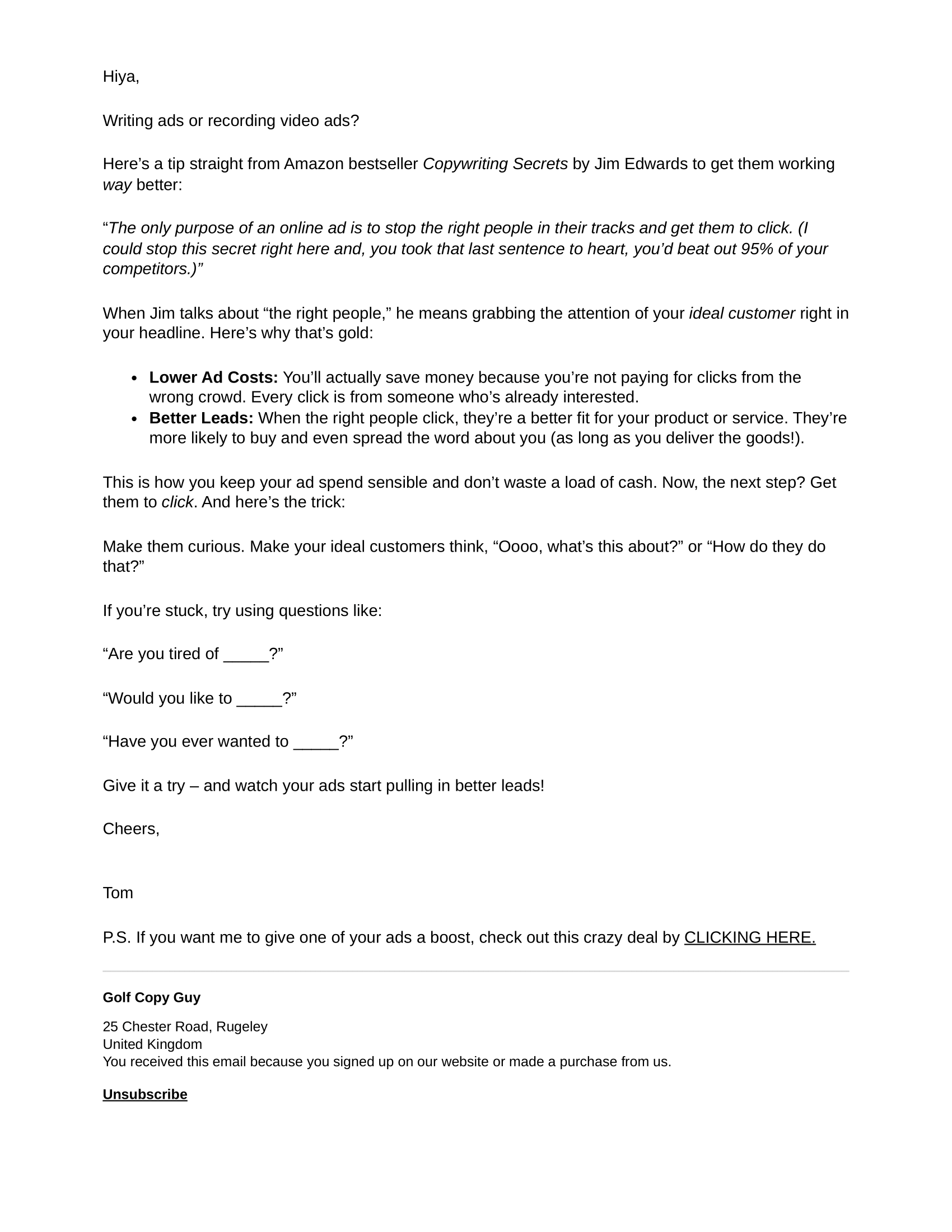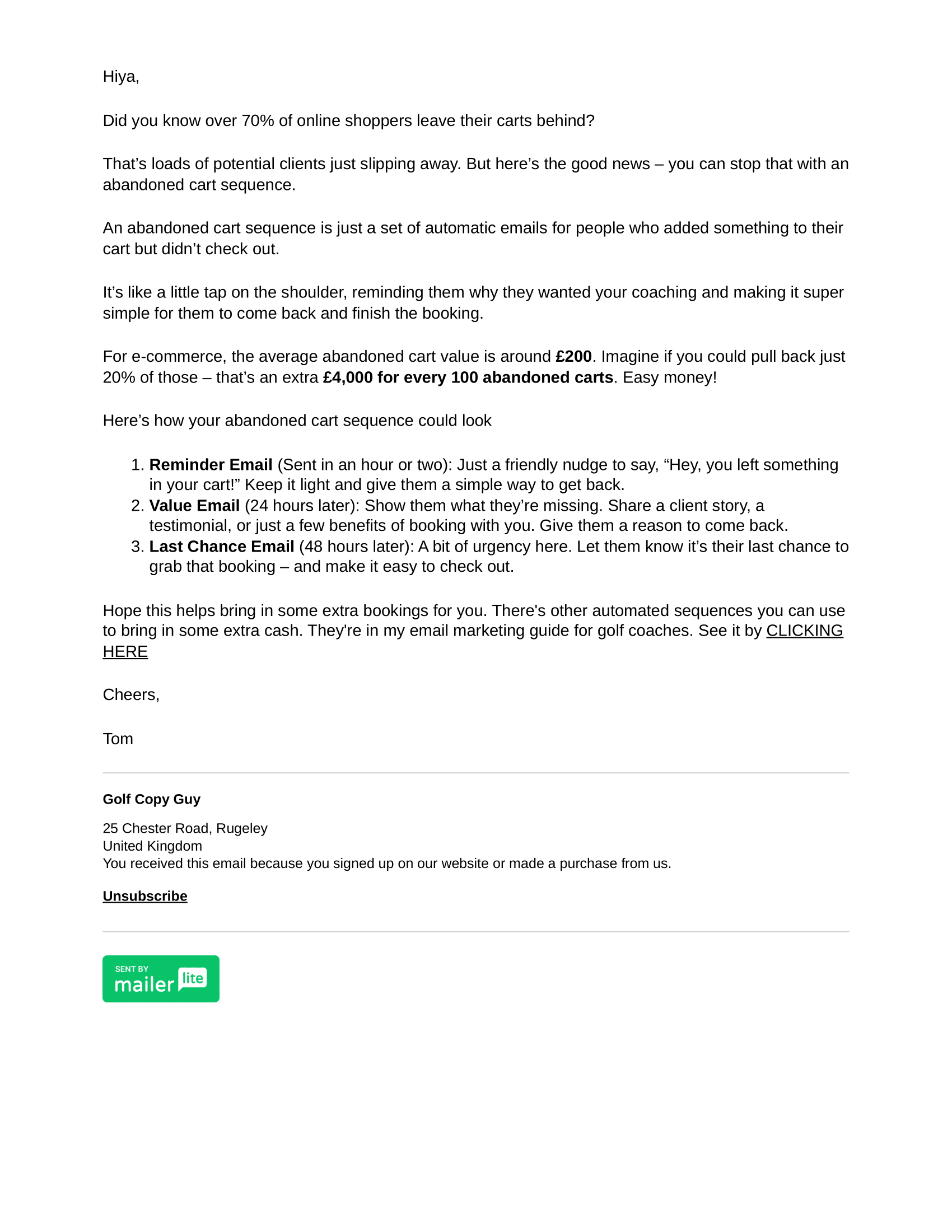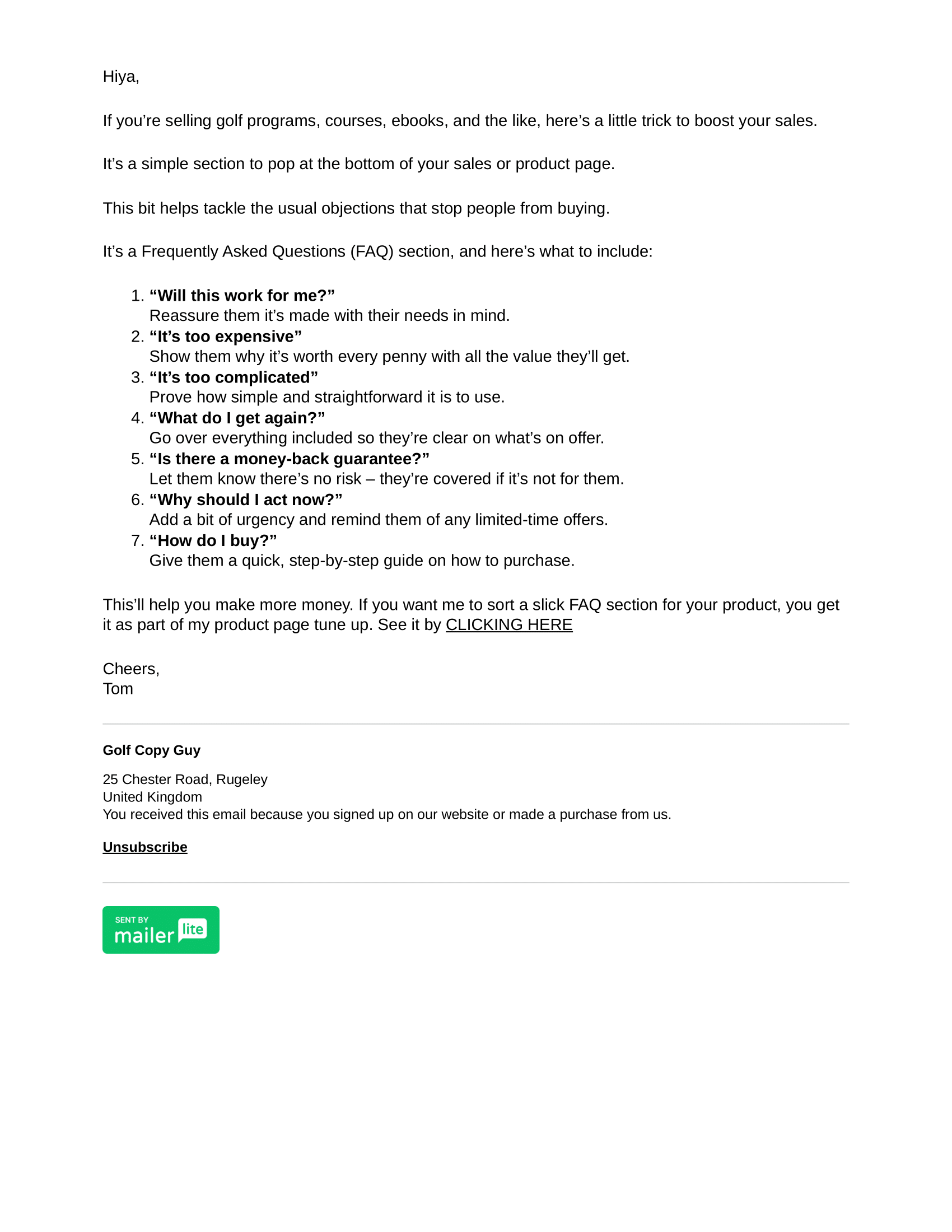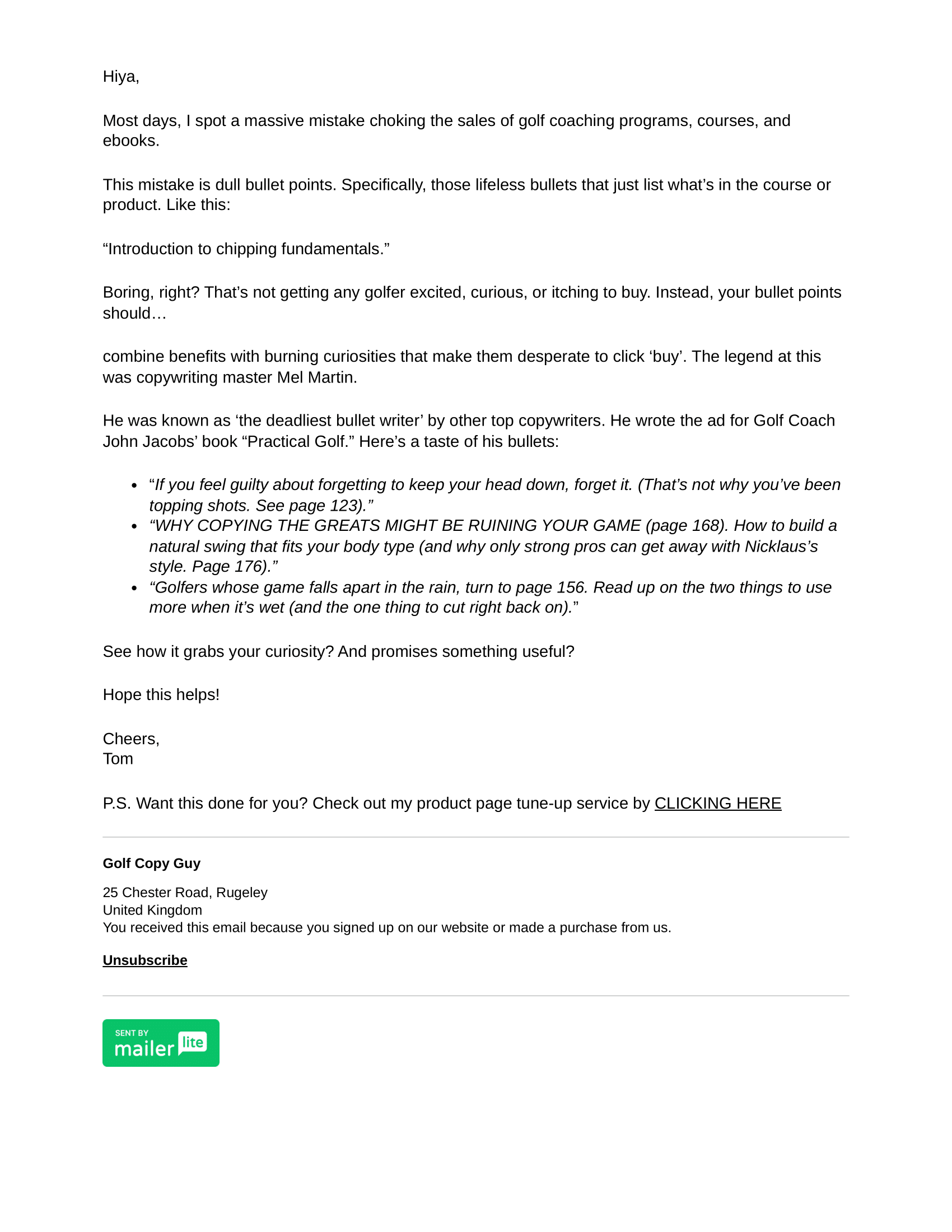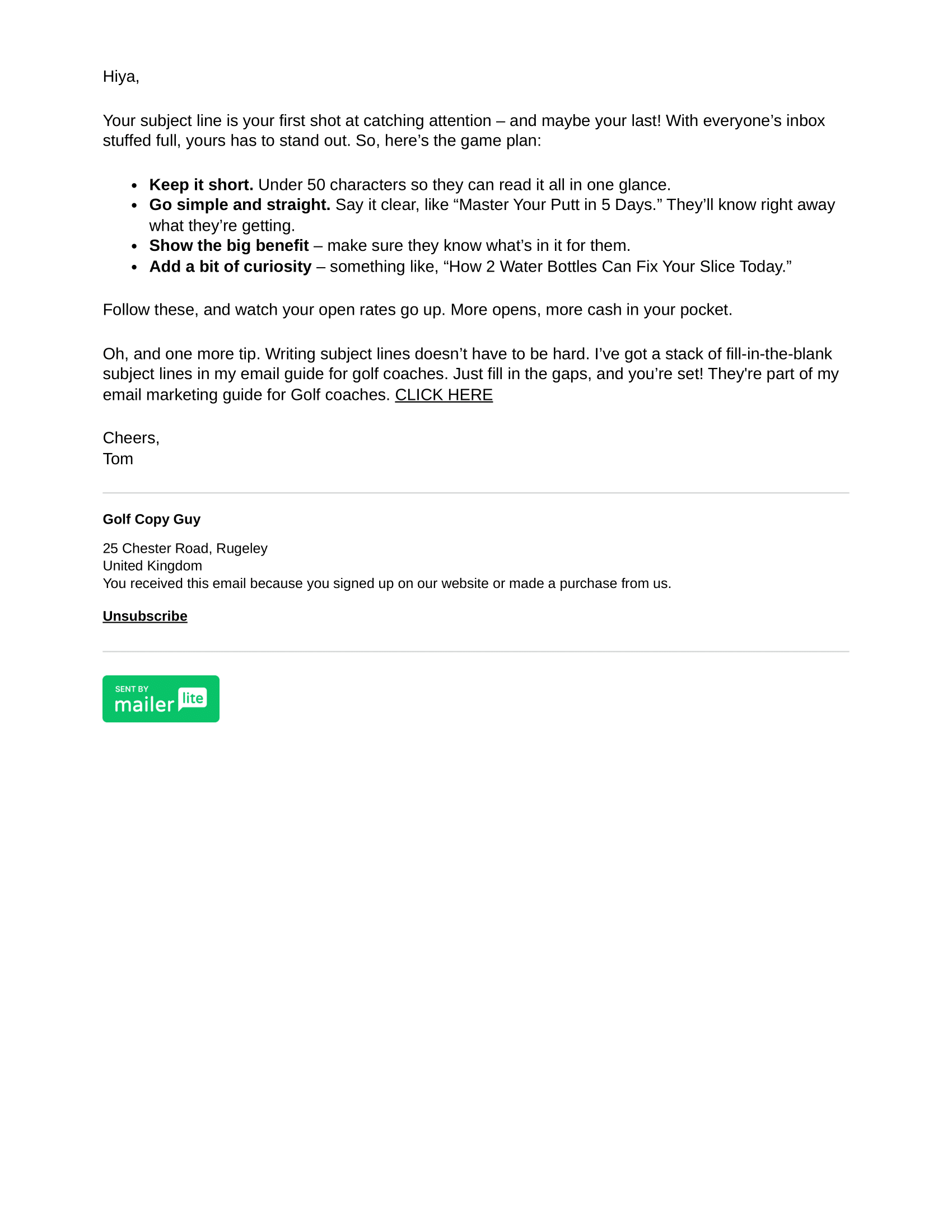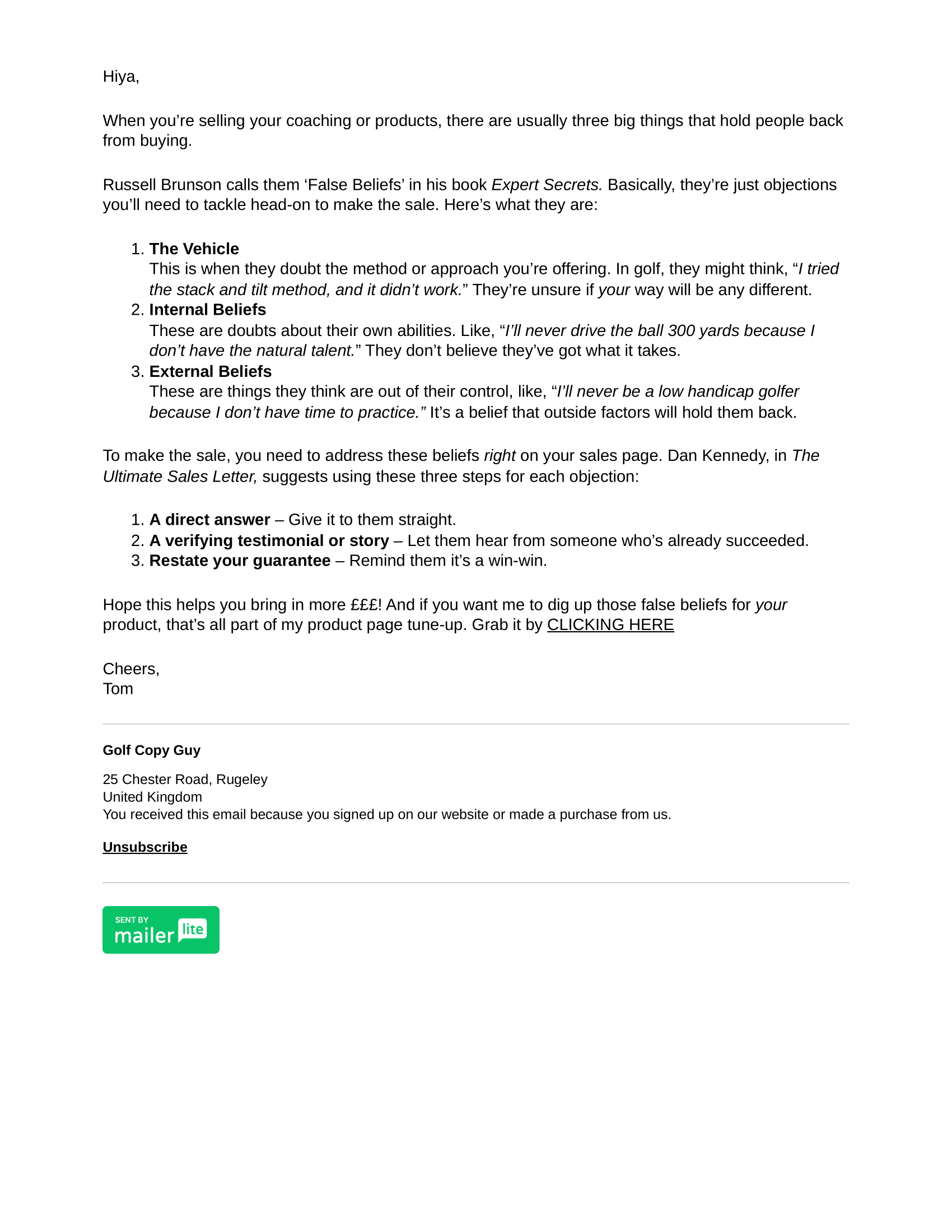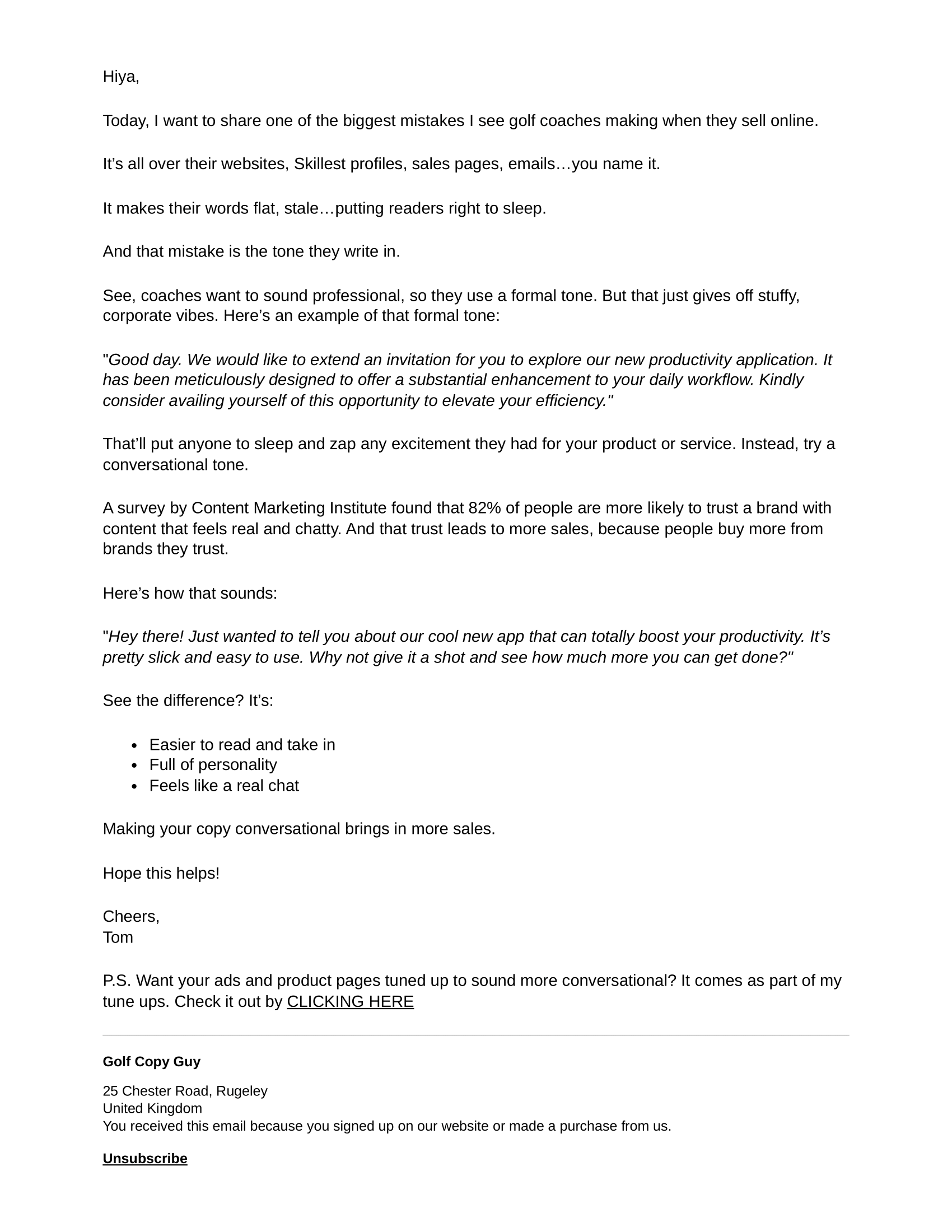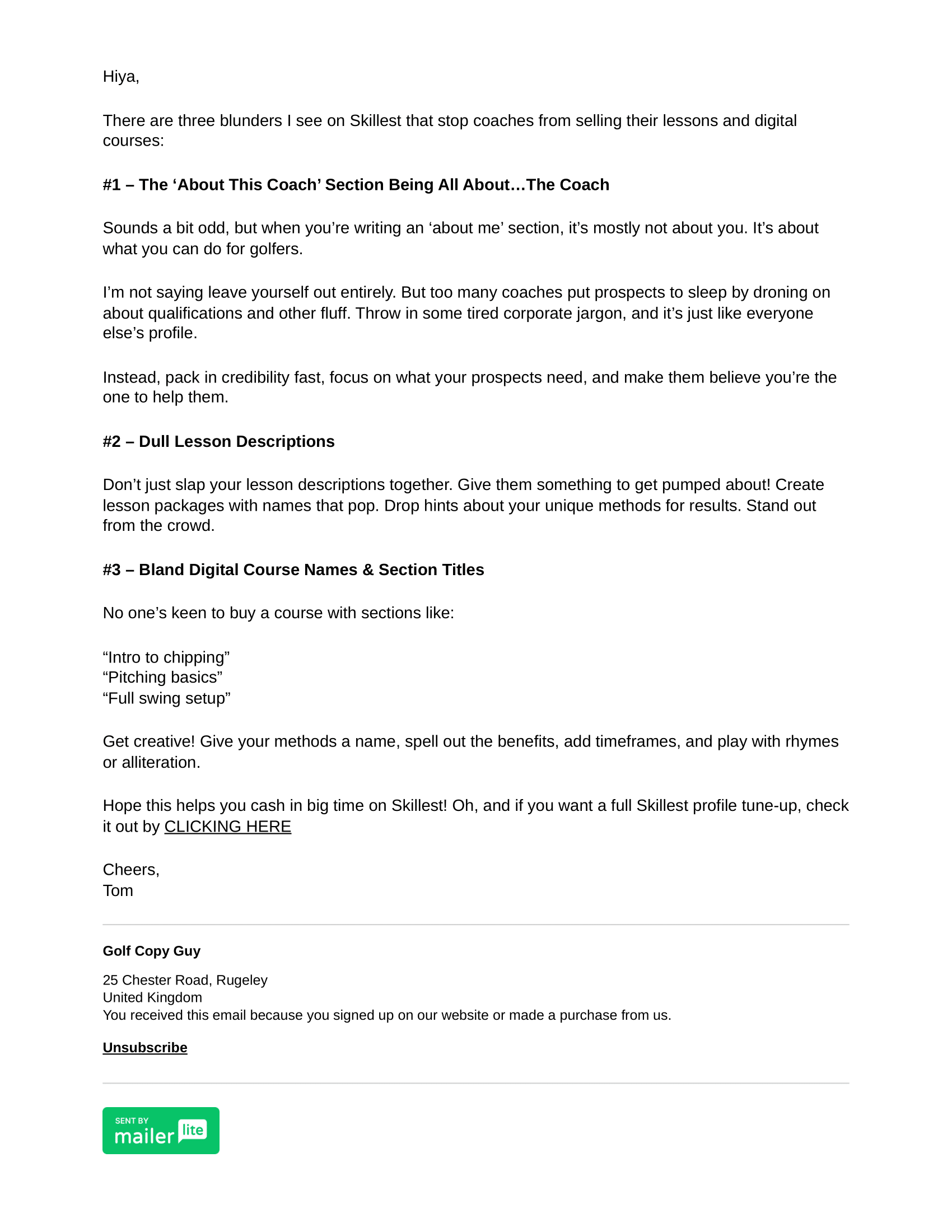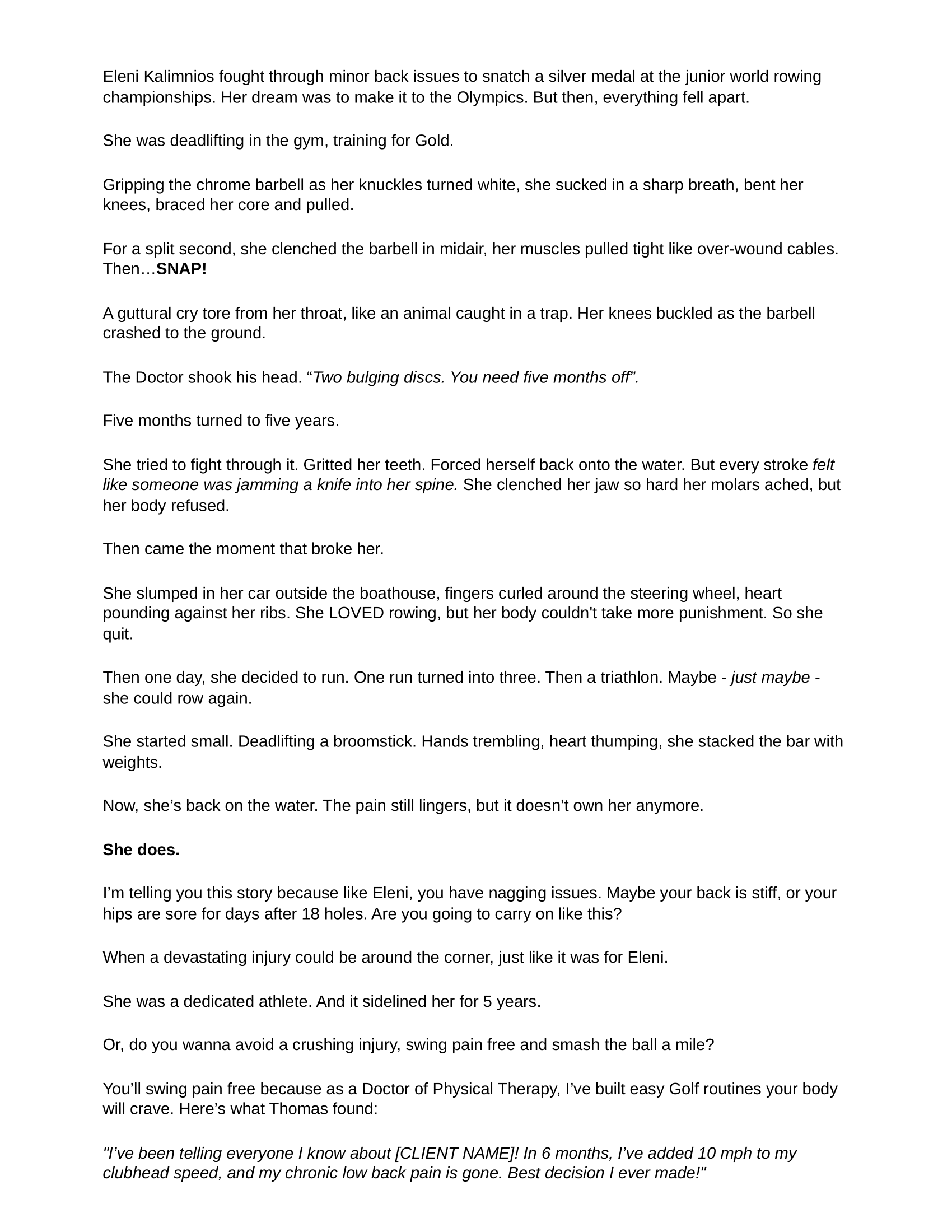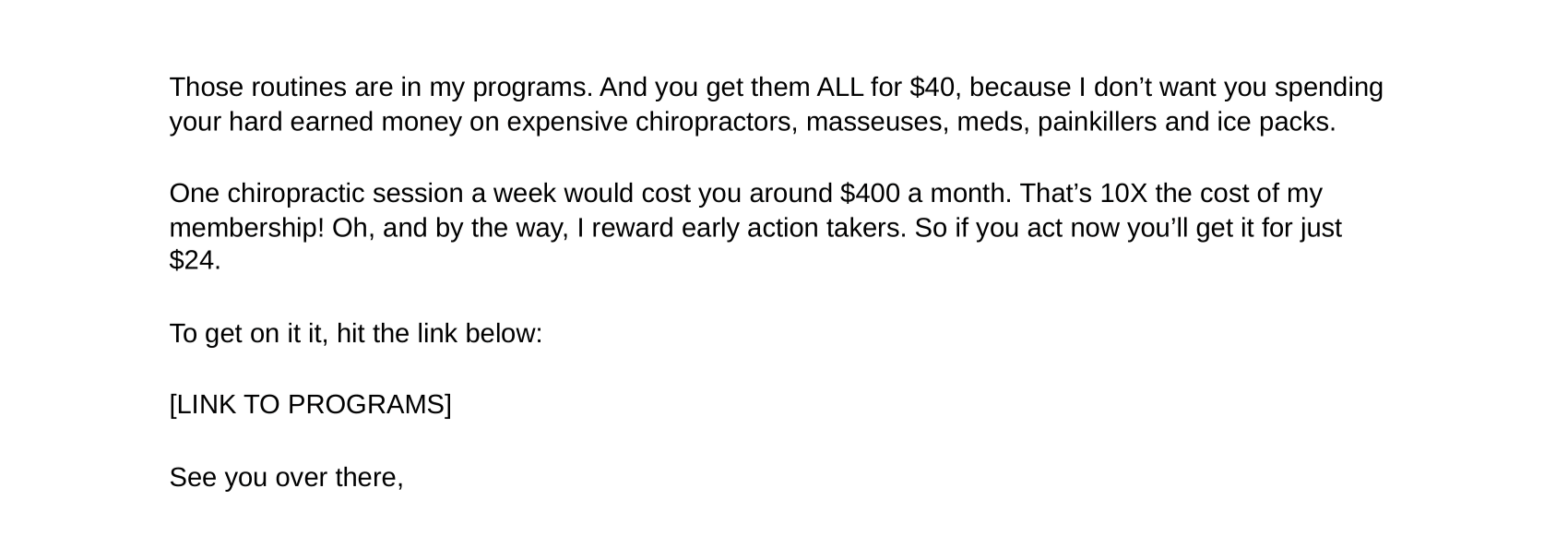Testimonials
Portfolio
Project - Golf Coach Accelerator (Long Form Sales Page, Facebook/Instagram Ad & Email Funnel)
This project was my own offer. The offer provides various ebooks, guides, checklists, toolstacks, audio/video trainings to help golf coaches grow their social media followings, build effective websites and save time using AI. The offer also includes a product or service page copy tune up, in which I’ll rewrite one of their website pages to land more students.
Below you'll see the copy and my breakdown of the long form sales page, Facebook/Instagram Ad and the Email funnel.
Long Form Sales Page
To see the live page, click the button below.
Breakdown of Long Form Sales Page
The Problem
There are thousands of golf coaches online, who are saturating YouTube and Instagram with content. Therefore, to grow online, golf coaches need to stand out to grow followings and get booked up. As part of the copy tune up, my intent was to find what makes each coach unique. You only have to visit Skillest to see the copy on each golf coaches page is similar.
The Audience
Golf coaches looking to boost their online presence (Social media, YouTube, paid ads etc). Particularly coaches who were selling digital programs, courses or ebooks.
Laying The Foundation With Avatar Research
As with any project, deep research on golf coaches allowed me to get inside their heads so I could speak to them effectively. This involved researching their:
Top 5 Google searches
Top 5 YouTube channels watched
Personality traits
Values
Interests
Fears
Complaints from existing solutions
Top 5 pain points
Bad decisions made
Criticism from others
Pre-existing worry
Biggest anxiety
Biggest embarrassment
What they feel guilty about
How they’d disappointed others
What happens if they ignore their problems
Top 5 challenges
Top 5 roadblocks
Lifestyle desire
Top 5 desires
What they’d want to escape to
Top 5 emotions
Top 5 beliefs
What makes them feel respected
What they want affinity to
Their expectations with my offer
Big result they’re looking for
Decision triggers
Objections
The Framework of The Sales Page
The framework for this long form sales page was a classic ‘Problem, Agitate, Solve’. In particular, the framework from the book “Copywriting Secrets” by Jim Edwards.
Use of Objections To Create Sub headlines
On a copywriting podcast, I heard a concept called “Storyboarding”. This copywriting concept from Agora Financial, involves using the main objections of a prospect as sub headings in a sales page. The aim is to stop the scroll and get prospects emotionally hooked into the sales page.
Use of Benefit + Curiosity To Write Persuasive Bullets
In my study of Copywriting greats, I came across Gary Bencivenga. His ultimate approach to persuasive bullet points was to combine benefits with curiosity. In order to play on the prospects greed for results, and curiosity to want to find out more by purchasing. For example:
“What to share (and what not to) if you want more clicks, DM’s and students.”
Use of A Strong Guarantee To Reduce Doubt
I wanted to give them maximum confidence this offer gets results. Which is why I said I’d give a full refund up to one year even if they were disappointed with only one aspect. I feel consumers don’t get excited by a standard 14 or 30 day money back guarantee.
Raise Perceived Value To Make It A No Brainer
I believe you must make the prospect genuinely believe the product is worth ten times the price they’re paying. This is done by applying realistic prices to each product, and brainstorming every possible benefit each product delivers to the prospects life. Specifically in line with what makes people buy, which are:
Make money
Save money
Save time
Improve their health
Gain respect
Escape mental pain
Avoid effort
Get more comfort
Gain praise
Feel more loved
Increase their popularity or social status
Create Rapport Through Empathy
The first paragraph of the sales page is the “Problem” section in which I’m relating to the prospect by reflecting on their daily struggles. This aims to build trust that I know exactly what they’re going through. Hence, they’ll trust I have the solution.
Result
I tested this offer initially with an ad spend on Facebook of £65. It made one sale at £79. The conversion rate for the sales page was 3.94%.
Reflection
I was happy with a 3.94% conversion rate to cold traffic. I genuinely believe the offer is packed with value, as you get around 50 ebooks, plus various checklists, toolstacks, guides, audio/video training. Not to mention the copy page tune up.
The one big area for improvement on this sales page was the authority. When I make an improved version of this sales page, I’ll delve into the proof of all the methods used in the ebooks.
Facebook/Instagram Ad Image & Text
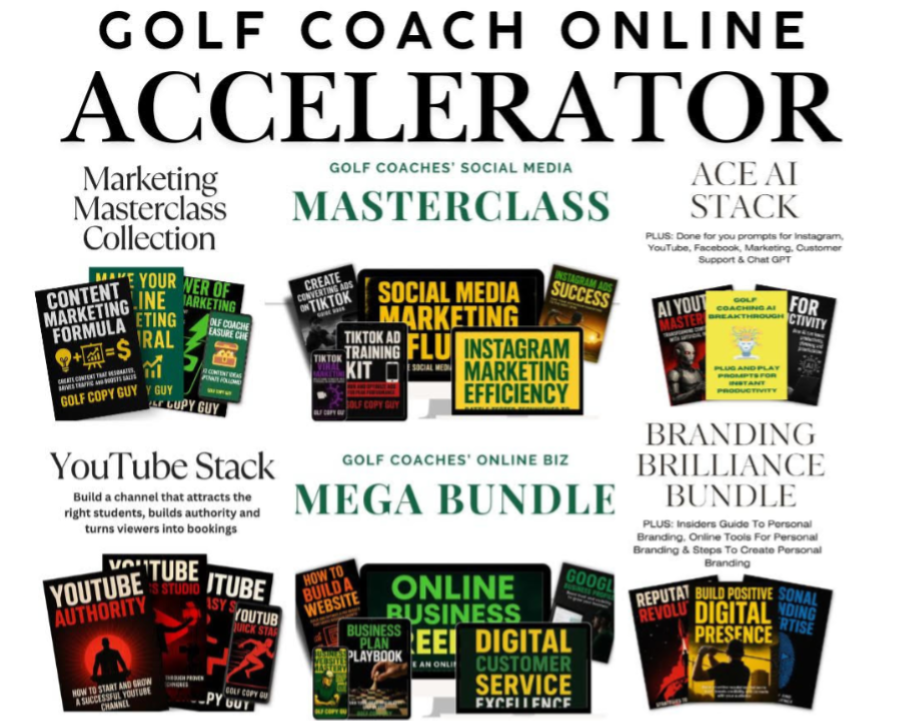
Ever wonder why some golf coaches blow up online, while others get left grinding for scraps?
It’s not luck.
It’s not posting every day ‘til your thumbs fall off.
It’s not some fancy editing app or algorithm luck either. Here’s what it is.
It’s tactics and strategies top online coaches don’t want you to know.
Like how to pick hashtags which get real engagement (so you don’t get lost in a sea of voices).
Or how to be 10X more productive whilst working less.
And how to follow up after a free swing review, so you stop getting ghosted. Even when the student said “That was amazing!”
These are just a few of the moves inside the Golf Coach Accelerator.
Which shows you how to:
✅ Grow your audience without burning out.
✅ Keep students coming back for more to cut the feast or famine cycle.
✅ Build a brand that makes you the obvious choice.
All without needing a tech degree.
Or an ad budget.
Or even a YouTube channel (yet).
Want in?
Click “learn more” if you wanna do it the smart way.
Copy Insights
Use of Curiosity To Hook The Reader
I like to create ‘open loops’ in the prospects mind to get them invested in reading all the copy. One way to do this is to use ‘not’ statements as you’ll see in the first 3 lines of the ad. The aim is to make the reader think “What is it then?” and read until they find out. The curiosity theme is then continued all the way through the copy as it doesn’t tell you exactly how the Golf Coach Accelerator works.
Destroying Objections To Create Belief
In my prospect research, I found 3 of the golf coaches' problems when trying to grow online is they weren’t tech savvy, didn’t have a big budget and some didn’t even have a YouTube channel. Which is why I’ve said you don’t need any of these to succeed. Thus creates belief and confidence in my offer.
Engaging Emotions Which Make People Buy
I believe people buy on emotions and justify on logic. Therefore, I’ll look for ways to engage my prospects emotionally. In this case, I’m using scarcity and a forbidden style approach by saying “It’s tactics and strategies top online coaches don’t want you to know”. Humans have a natural need to find things which are being kept from them. Plus, it raises it’s perceived value. It also touches on envy, as the prospect thinks what’s being kept from them is why others are ahead. All this makes it more tempting to buy.
Email Follow Up Funnel
Overview
I tested offering a lead magnet up front followed by this email flow to get prospects to buy the Golf Coach Accelerator. I tested it with a £25 Meta ad spend.
The Result
This flow sent 536 emails to 24 subscribers, resulting in:
2 sales
Overall open rate of 67.14%.
Click to open rate 4.79%
Clicked rate of 3.21%
Email #1 - Welcome Email
The goal of this email is to:
Build rapport and trust instantly.
Outline exactly how I can help them.
Set expectations they’ll receive useful advice.
Whitelist me so my emails land in their inbox.
Encourage them to reply for better email deliverability.
Subject Line: Welcome! Here's what to look forward to...
Body:
Email #2 - Conversation Starter
The goal of this email is to:
Increase prospect engagement.
Further help my email deliverability.
Open up opportunities to figure out what they want, qualify them, and allow you to point them to the right solution for their situation.
The key to this email is not a hard sell. It’s to simply start a conversation as if you were speaking to a friend. Which is why it’s informal, short and conversational.
Here's the email:
Subject Line: Tell me about you
Body:
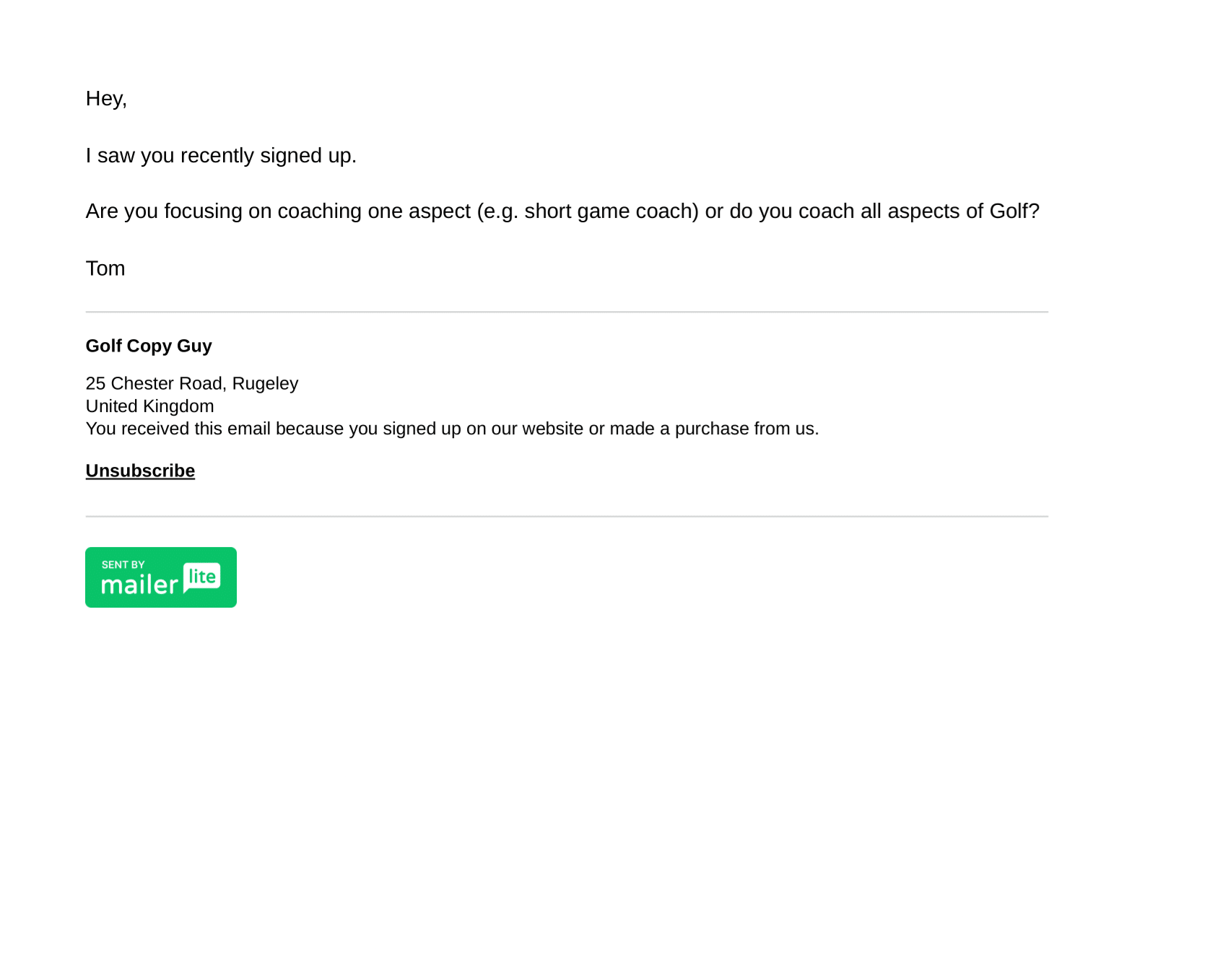
Email #3 - Origin Story
The goal of this email is to further build the ‘know, like and trust’ factor through storytelling. This email reveals challenges and vulnerabilities from the past which humanizes me and makes me relatable. I don’t believe in trying to sound perfect, because that’ll raise scepticism. There’s a real person here, not a faceless corporation. That’s what helps a deep connection with the prospect.
Here's the email:
Subject Line: Wanna sell in 2024? Ditch this
Body:
Email #4 - Credo
The goal of this email is to state what I stand for (and what I don’t). I believe trying to be everything to everyone sets you up to fail. Instead, be ok with losing prospects, so long as you’re building an army of loyal fans. Therefore I’m looking to:
Share my beliefs which tap into my prospects already existing beliefs.
Keep building more ‘know, like and trust’.
Clearly stand for something so I’ll never be alone.
Other notable points:
By asking “As a golf coach, would you agree details matter?” is aimed to get a small ‘yes’ in the mind of the prospect. This makes them more receptive and trust details go into my work as a copywriter.
By writing “Whether it’s if your wrist is cupped or bowed at the top of the swing…or where the V’s are pointed to in your grip…it all affects ball flight, right?” I’m demonstrating my knowledge of the golf swing. This is to build trust with golf coaches I’m trying to sell my copy services to. A key objection for golf coaches is hiring copywriters who know little about golf.
Subject Line: Which one of these 3 are you?
Body:
Email #5 - Reason Why I’m Different & Superior
The goal of this email is to separate me from the crowd. Similar to a ‘unique selling proposition’ or ‘unique selling point’. Here’s the structure of the email:
Tap into a problem they’re experiencing as a golf coach.
Highlight how past solutions they’ve tried before haven’t worked.
Explain the real cause of the problem.
Highlight the real solution.
Tie it back to my own service.
Subject Line: 3 questions every top online biz asks
Body:
Emails 6-24 - Give Value, Create Curiosity & Sell The Click
Each of these emails follow a similar structure, which is:
Give value upfront to help them solve a problem.
Make them curious to click a link to my sales page.
These emails are mostly short. They're useful and written in a conversational tone to built trust. However, I’m only selling the click, not my offer. It’s my sales page’s job to sell my offer.
Other points to note:
Use of Shocking Statements To Hook Readers - In some emails you’ll see the first line of the email gives a shocking statistic aimed at the reader. I do this to get the prospect to think “Wow I need to read this”. Once they’re emotionally invested, they’ll keep reading.
Provide Genuine Value But Always Sell - Each email contains useful information for the prospect. I never want to get the prospect to ignore my emails as they think it’s all sell, sell, sell. However, as you see, I always find a way to link in the product I was selling, even if it’s just in the P.S.
Use Super Easy To Read Formatting - People are busy and have no patience and small attention spans. My emails have one, two or maximum 3 line paragraphs and are shortish mainly. This doesn’t overwhelm the reader when they open the email, making them more inclined to read.
Client Project - Golf Coach Video Subscription Sales Page Rewrite
Overview
In this project I rewrote a client's golf coaching sales page. He has a subscription based website in which buyers get access to a library of golf instructional videos, to help them play better Golf.
My Approach
The first step as in any project was to do avatar research. A detailed breakdown of golfers' fears, desires, results, challenges, objections, questions and beliefs.
The next step was to watch all of the coaching videos inside the subscription. This allowed me to build a huge list of benefits to create maximum value for a prospect. Additionally, I looked for details which would be contrary to the prospects beliefs, to surprise them. These would be used as curiosity bullet points on the sales page, and potentially for headlines as they’d grab attention.
Copy Highlights
Build Curiosity With Counterintuitive Bullet Points
Once I understood how the prospect thinks, I knew what content in the subscription would peak their curiosity. By creating an ‘open loop’ in their mind, the only way to close it would be to buy. Many golfers assume swinging faster will hit the ball further. Which is why I’ve written the bullet “”Why slowing down your swing actually makes you hit it further”.
Crush Objections In Bullet Points
During my prospect research I found objections which I crushed whilst combining them with benefits. For example, a common objection was golfers not having time to hit thousands of balls in practice. Which is why I wrote “How to fix your swing without hitting a single ball”.
Use Golf Legends To Build Authority
My client has got some of the golf drills in his content from some of the best golfers to play the game. Which made it possible for me to use it to build authority. If a golfer thinks 7 time major champion Nick Faldo does this drill, it must be a good drill right?
Find My Clients USP
There are thousands of golf coaches out there. So I needed to find what is unique about my client otherwise he’ll get lost in a sea of competitors. During the client call, I found out he was only 1 of 9 Malaska Certified Golf coaches. This is an accreditation from Mike Malaska, one of the highest rated coaches on the planet. This stands him out from thousands of other golf coaches.
Build My Clients Credibility To Boost Conversions
Similar to the previous point, my client is only one of nine coaches who are certified to teach Mike Malaska’s ‘M System’. With Mike being a Golf Digest Legend of Instruction, and handpicking my client to teach his system, makes you think my client must be a good golf coach to achieve this. This gives the prospect confidence he’ll solve your golfing issues.
I'm waiting for the client to upload the copy to his website, so I can get a screenshot. Here's the copy:
Swing Simplicity
Get in on ‘The M System’ to kill confusion, stubborn bad habits, and start smashing it miles
[BUTTON - START YOUR FREE TRIAL]
Here’s EVERYTHING you get…
Putting It All Together: Building An Athletic Golf Swing Video Series (£47 Value)
If your swing feels out of whack, this video series will get you back on track. You get the secret to a smooth, repeatable swing. It all comes down to nailing three key things: rhythm, tempo, and timing. Inside this video series, you’ll also find out:
Why slowing down your swing actually makes you hit it further. Sounds backwards, right? But smooth and steady beats fast and frantic every time—just ask Ernie Els.
The easy way to add 20 yards without swinging harder. More distance without extra effort? Yep. One simple rhythm tweak gets you hitting it flush—and using shorter irons into the green.
Why bad posture wrecks your swing (and your back). Too much knee bend? Stiff spine? That’s a one-way ticket to weak shots and a sore back. Here’s how to fix it so you hit it longer and feel better doing it.
Why your feet matter more than your hands in your swing. Your hands don’t run the show—your feet do. Shift your weight the right way, and you’ll pure it every time. (Bonus: You’ll be launching those low, piercing bullets that cut through wind like a knife.)
How to fix your swing without hitting a single ball. This “All Together” drill (straight from a Ryder Cup legend) gets your whole body working in sync. No range time needed.
The perfect takeaway (and how to nail it every time). A bad takeaway is a slice waiting to happen. The “Front Loader” drill keeps your club on plane and your shots on target.
Your tempo controls everything—power, timing, and confidence. Nail your rhythm with this easy 4-count trick, so even when your nerves are off the charts, your swing stays rock solid.
The #1 drill for effortless power. Want raw speed and distance? Master Mike Malaska’s “L to L” drill and unlock up to 80% of your swing’s power in one move. Perfect if you’re short on practice time.
How to grip it for max speed (without losing control). Hold it too tight? You lose distance. Too loose? Shots spray everywhere. Here’s the exact grip pressure and finger placement the pros swear by.
Master the Golf Swing: Unlock the Lever System & The 11 Links Video Series (£49 Value)
I’m breaking the golf swing down into 11 simple parts.
That means no more guessing, no more conflicting advice—just a clear roadmap to striking it pure. This is the fastest way to build a swing that actually sticks. Inside, you get:
How to nail the perfect top-of-swing position. Nick Faldo’s ‘Pre-Set’ drill gets you loaded like a slingshot. Mess this up, and you’re stuck making last-second compensations (aka inconsistency central).
What really matters after impact. Most golfers think once you hit the ball, the job’s done. Not true. Here’s what to do post-impact to control your clubface and keep shots on target.
The #1 mistake your forearms must avoid in the takeaway. Make this move, and you’re practically guaranteeing a slice. Here’s how to stop it before it ruins your scores.
The traditional swing advice you should ignore. A lot of classic tips actually lead to bad habits that kill your consistency. Find out what to ditch for good.
The “Thumbs Up” Speed Hack. This one simple wrist move unlocks serious clubhead speed. More speed = shorter irons into greens = less pressure on your short game.
The “Pressure Shift Power Move.” Stop fat and thin shots for good by mastering weight shift. Start compressing the ball so your irons fly high, land soft, and stick near tucked pins.
Hit more greens in regulation—immediately. Align your swing plane the right way, and watch your accuracy go through the roof. More greens = more birdie chances.
Add distance without swinging harder. Learn how to create and hold lag, then release it at the perfect moment to whip the club through impact. Get this wrong, and you’ll be stuck with the dreaded chicken wing.
Are your wrists helping or hurting your swing? Hinge them correctly, and you’ll launch it high and long—carrying hazards instead of laying up in front of them.
BETTER THAN ENDLESS RANGE SESSIONS. Master these 11 links and build lasting muscle memory—faster than hitting buckets of balls ever could.
BETTER THAN BINGE-WATCHING YOUTUBE. No more scrolling through contradicting tips. Get a step-by-step system that actually works, so you can stop overthinking.
Build Perfect Body Motion Video Series (£37 Value)
In this video series, you’ll learn how to coil up tight. So when you get to the top—you’re primed to unleash power. Then, you’ll glide into your lead side and catch it flush, every single time. Oh, and here’s the kicker… mastering these moves means you’ll be playing pain-free no matter your age or aches. Inside, you get:
The Figure-8 Hip Move. This drill cranks up your clubhead speed, so you’re hitting shorter irons into Par 3s and landing it soft. So you stop rolling off the greens to face a tricky up and down.
How to stay in perfect posture to avoid early extension. Early extension ruins shots by making you flip your hands through impact—leading to blocks and snap hooks. Fix this, and your contact’s pure.
Why swaying wrecks your distance control (and how to stop it). Fat shots, thin shots, unpredictable irons… sound familiar? Learn how to stay centered so you pick the right club and never come up short or fly the green again.
Think you’re not flexible enough for a full turn? Think again.
With the “Piston Power Drill,” anyone can unlock deep, powerful rotation—even if you’re as stiff as a board.How to fix reverse pivot and shift your weight like a tour pro. Pure strikes come from proper weight transfer. Master this, and your irons will cut through the wind instead of ballooning off-course.
Why your hips and shoulders need to move in opposite directions. Most golfers get this transition move wrong, costing them serious speed. Here’s how to do it right—and add enormous power.
The follow-through move that leads to straighter, longer shots. Feeling your left hip move back in the follow-through? That’s the secret to consistency, and here’s how to train it today.
Think you’re coiling properly? You might be losing power. A big turn doesn’t always mean more distance. Here’s a simple way to check if your backswing is actually setting you up for power—or wasting it.
A simple chair or kitchen counter trick for perfect spine angles. With this move, you’ll pure it no matter the lie—tight fairways, deep rough, or even sidehill lies.
Weight shift isn’t about moving back and forth—it’s about foot pressure. Get this right, and you’ll pinch the turf and compress the ball with an echo that bounces off the trees.
ADD YARDS TO YOUR DRIVES by mastering ground forces. Turn the energy under your feet into explosive power, so you start reaching par 5s in two—without swinging harder.
The Short Game Video Series (£29 Value)
Sick of the yips? This video series gives you the skills to chip it close and tap it in. So you're not sweating over every iron shot. Miss a green? No problem—you’ll be getting up and down like it’s nothing. No more chunks. No more bladed shots flying across the green. No more 3-putts. Just a rock-solid short game that makes scoring easy.
Inside, you’ll get:
How to “cheat” impact for pure contact. Set your low point ahead of the ball with this simple setup tweak, and you’ll never chunk a chip again.
Dial in your chipping distance like a master. Learn how to match your backswing and follow-through lengths for spot-on distance control. Now you’ll be tapping in for par, not grinding over 8-footers.
Why your wrists and forearms might be sabotaging your putts. If you can’t keep your stroke straight, this is the fix you need to start rolling it bullet straight.
Why less movement = better chips. The “Chip Putt” technique is the shortcut to reliable, stress-free chipping—no extra moving parts, just solid results.
The secret to chipping from thick rough. It’s not about power—it’s about hitting the ball in the right spot on the clubface. Get this right, and you’ll pop it out with control every time.
Why the bump-and-run is your best friend. Short strokes mean fewer mistakes. Here’s why keeping it low and simple is the smarter play over risky high shots.
Why your putts keep coming up short (even when you think you’ve hit it well). This quick fix gets you rolling the ball the right distance—without changing your stroke.
Think a longer backswing makes putts go farther? WRONG. Hitting the centre of the putter face is what really matters. Nail that, and you’ll stop leaving putts short.
How modern club lofts have changed chipping—and what to do about it. Stronger lofts mean different ball flights. Master this updated loft strategy, and your chips will be predictable and accurate.
The forgotten Seve technique that sharpens your aim on short putts. Most golfers overlook this key directional control trick—but once you use it, you’ll start draining putts like magic.
Ball Flight Laws Video Series (£27 Value)
Sick of guessing what’s wrong with your swing?
This video series is the ultimate swing fix. Whether you're slicing, pushing, hooking, or drawing it too much—you’ll finally understand why it’s happening (and how to fix it for good).
A LOT of golfers think they hit a slice… but in reality, it’s a push slice. That’s a whole different problem, and if you try to fix it the wrong way, you’re just making things worse. No wonder so many golfers feel like chucking their clubs in the nearest lake!
You’ll also learn how to shape shots on command, so you can:
Hit a long, controlled draw around dogleg fairways.
Stick a high fade that lands soft by a tucked pin.
PLUS, you’ll get:
The “Ask Matt” Series – Real golfer questions, real answers. Quick fixes for the most common swing faults.
The “Beginner’s Golf” Series – Simple, powerful drills to help new golfers master the biggest parts of the swing early.
The “Simplifying the Game” Series – Say goodbye to swing confusion. With so much advice floating around YouTube and Instagram, your mind can turn into a mess of mixed signals. This series gives you straightforward swing thoughts so you can play without overthinking every move.
TOTAL VALUE - £
PRICE - £ A MONTH
[BUTTON - START YOUR FREE TRIAL]
See what others think about my videos…
“Matt is one of the finest instructors out there. His approach is easy to understand and clear.”
“This video has solved my heel strikes/shanking for good. Suffered for nearly 10 years. You are a life saver.”
“When I tried this I was crushing the ball. Hit it 15-20 yards further with every club.”
“Matt, I believe you to be one of the finest online teachers, you address the issues that affect the lack of consistency of the majority of golfers not the 10% elite golfers who basically can go most things anyway. I found your LDL drill brilliant, really a meaningful benefit taken to the course immediately but mainly for irons.”
How To Use Momentum Correctly With The ‘Malaska Move’
If your ball flight is all over the place, there’s a good chance you’re rolling your forearms through impact—and that usually means you’re coming in too shallow on the downswing.
In the video below, you’ll learn the ‘Malaska Moves’—a simple way to drop the club into the perfect slot. Nail this, and you’ll start hitting high, controlled draws that land soft instead of spraying it all over the course.
No more guesswork. No more inconsistency. Just solid, predictable ball-striking.
[VIDEO]
Why I’ll slash your scores…
For over 25 years, I’ve been showing golfers how to hit lower scores with a swing that’s simple, smooth, and repeatable. No more breakdowns. No more blow-ups on the course.
And here’s the kicker—I’m one of just 9 coaches on the planet trained to teach “The M System.” It’s the easiest way to lower your scores that I’ve ever come across, created by the legendary Mike Malaska. Yep, Golf Digest named him a Legend of Instruction in 2024, and he’s only trusted a handful of coaches with his system.
This method is a game-changer. Just ask Rob—he used to struggle to break 100, but now he’s dancing around 80.
What’s the secret? The M System tosses out all the confusing swing mechanics that tie you up in knots. Instead, it helps you swing with rhythm, flow, and ease.
I’m combining what I’ve learned from Mike and David Leadbetter with my own 25+ years of experience to give you everything you need to slash strokes off your game.
Client Project - Golf Fitness Emails
Overview
My client provides specific golf fitness advice for players to gain strength, mobility, endurance and prevent injury. He has different video series on his website in which golfers get access to via paid subscription. My client wanted a variety of emails to entertain and educate his list, whilst also selling.
The target audience was his email list which contain golfers who experience physical pain in various forms, limiting their ability to play while also hurting their scores. The goal of these emails is to get prospects clicking to my clients website. My aim was to drive home the importance of looking after your body through simple exercises, rather than relying on painkillers.
To get prospects to take action, I targeted emotions like frustration, helplessness, fear and hope.
Email #1 - Bill Walton Story
This email was an opportunity to entertain the prospects with a gripping story, whilst raising the stakes around ignoring their body's pain signals. The story tells of the physical decline of NBA legend Bill Walton. Although it's not a golf specific story, prospects will relate to Bill Walton's pain points. Here are my copy highlights:
- The subject line - "his aches got worse, then he collapsed" aimed to stop the prospect in their tracks as they ache too. It hints at serious consequences, triggering fear. I chose the visceral word "collapsed", as it hits harder than "fell". It's also short, so it's conversational and gives you the full effect in a glance (as they scroll through their inbox). Lastly, it opens a loop in the reader's mind which they can only close by opening the email.
- The hook (first 3 lines) aims to intrigue the reader. There's no pitch, no promo, just the start of a story. Also, I aimed to create instant relatability for the reader by describing the "stiff, achy wake up".
- After stating the problem, I agitate the pain using sensory verbs such as "slammed", "shooting" and "drilled". Additionally, I aimed to portray rapid escalation by going from stiff to surgery in under 200 words. This was to create fear and urgency in the prospects' minds.
- Emotional pivot and warning - I wanted to give the reader a short stark warning by saying "take care of your body, or pay the price." This aimed to put the reader at an instant crossroads, asking for action. Also, by using it as a direct quote from Bill Walton, it commands authority and doesn't come across as my client preaching.
- Transition to the reader's world - With the line "right now, maybe your body feels stiff, tight or sore. So what do you do?" I bring the focus onto the reader from the story. I then go on to talk about painkillers and pushing through, to remind them it's not sustainable.
- Appearing new or forbidden - the line "no one's shown you how to move in ways your body craves" is hinting it's something they've not seen before (unique) and implies a forbidden sense, which makes them curious to check it out.
Here's the email:
Subject Line: His aches got worse, then he collapsed
Body:
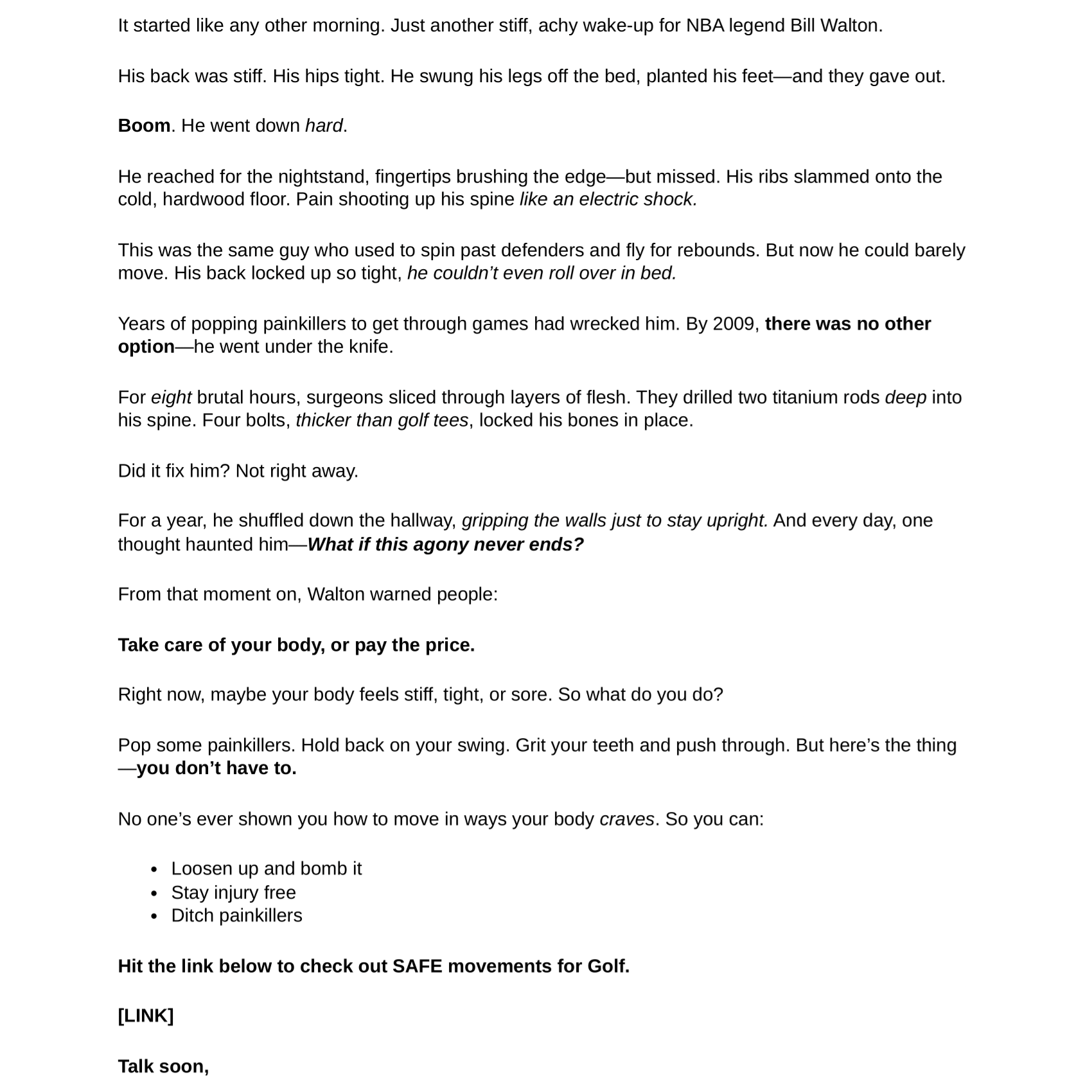
Email #2 - Painkillers Study
My client said lots of his customers take painkillers to get them through a round of Golf. It's my job as the copywriter to sell the prospect on a healthier way to reduce their pain (through my clients programs). Medical studies from established researchers carry authority and credibility, making them persuasive. Particularly if they're recent studies. Therefore I searched for new studies on the side effects of painkillers. And found new research suggesting harmful side effects.
Now I had an angle to create fear and put my prospects at a crossroads to take action (if they don't find a safe way to reduce their pain they're gonna get nasty side effects). Here are my copy highlights:
- Subject line - the use of "new" creates immediacy. The use of "horrors" creates a visceral effect to hit the prospect in the gut.
- Hook - "if you take painkillers just to make it through 18 holes, you need to hear what researchers just found" - this calls out the target prospect and opens a loop in their mind for them to read on.
- The use of the name of the journal and the date adds credibility and authority. This proof is backed up with "580,000" records, suggests a huge study.
- The use of "heart failure" was to instil real fear and seriousness.
- I know my client himself used to use painkillers, so I added this in to create empathy with the reader (my client has been through the same). This confession also adds a human side to my client.
- By saying the safe exercises can be done "in less time than it takes your coffee to cool" makes it doable to the prospect. This isn't hours upon hours of exercises.
Here's the email:
Subject Line: New study reveals painkiller horrors
Body:
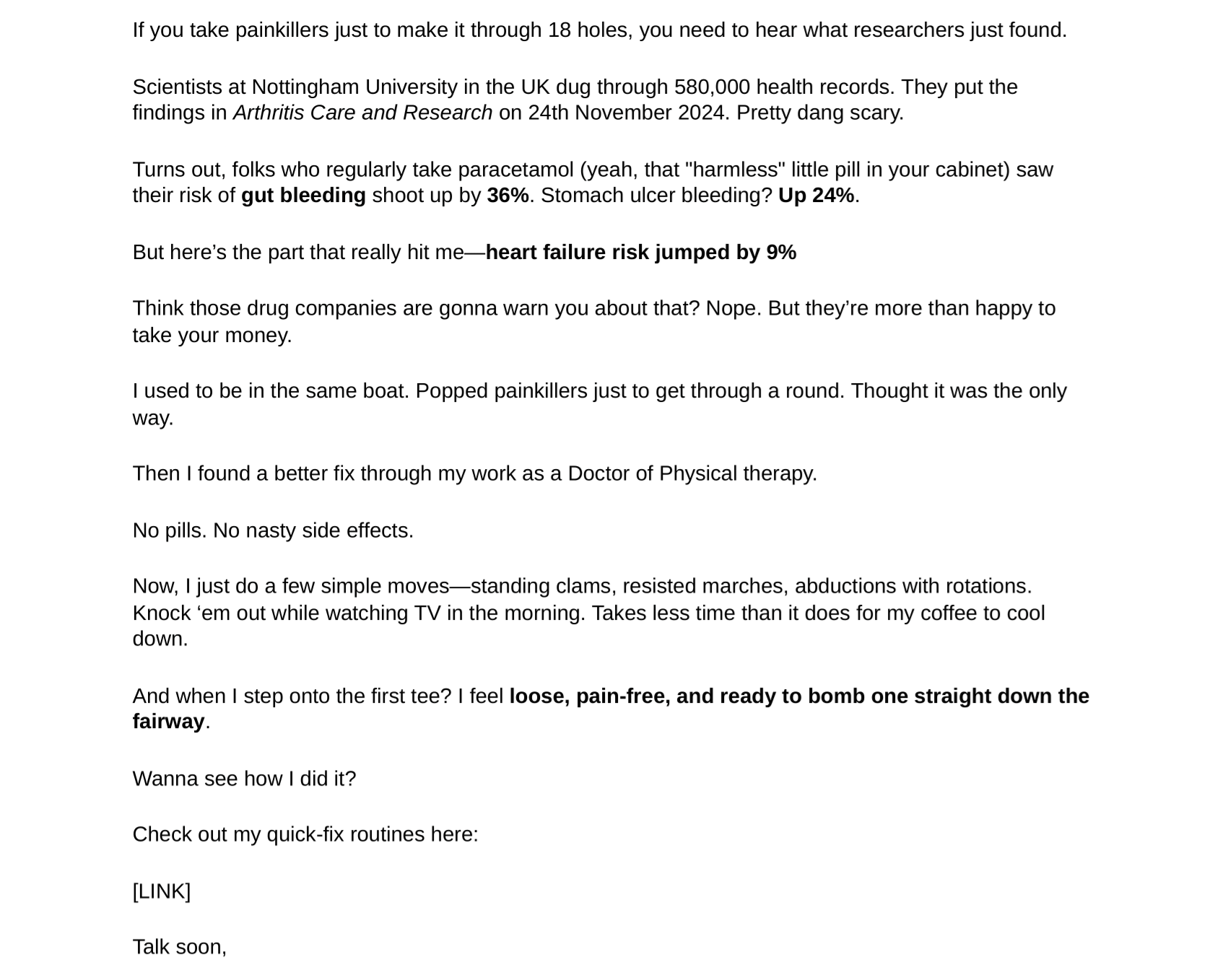
Email #3 - Early Extension
Early extension is a fault in the golf swing which causes a golfer to miss the target both right and left. Physical problems such as weak glutes, tight back muscles can make early extension worse. My client has a exercise program specifically designed to ease early extension by strengthening muscles and creating mobility. So golfers can hit straighter shots for lower scores.
My approach with this email was to create frustration and even anger about their game, to encourage them to take my clients solution. Here are my copy highlights:
- Agitating the problem and empathizing with the reader - "you've tried everything - slowing down, staying loose, even lessons". This removes blame from the reader and tells them they're not lazy. I'm validating their efforts and building trust my client has the real solution.
- Reframing the fix - "you can't fix your swing if your body won't let you move the right way". This moves the reader from blaming their swing to blaming their poor movements. It also takes away other solutions - they must fix their body (through my clients programs).
- Helplessness to hope - Having aimed the prospects to feel helpless by poking at their frustration and anger with their game, I gave them hope by saying "you can fix your body with a few simple drills".
Here's the email:
Subject Line: Sick of missing left and right?
Body:
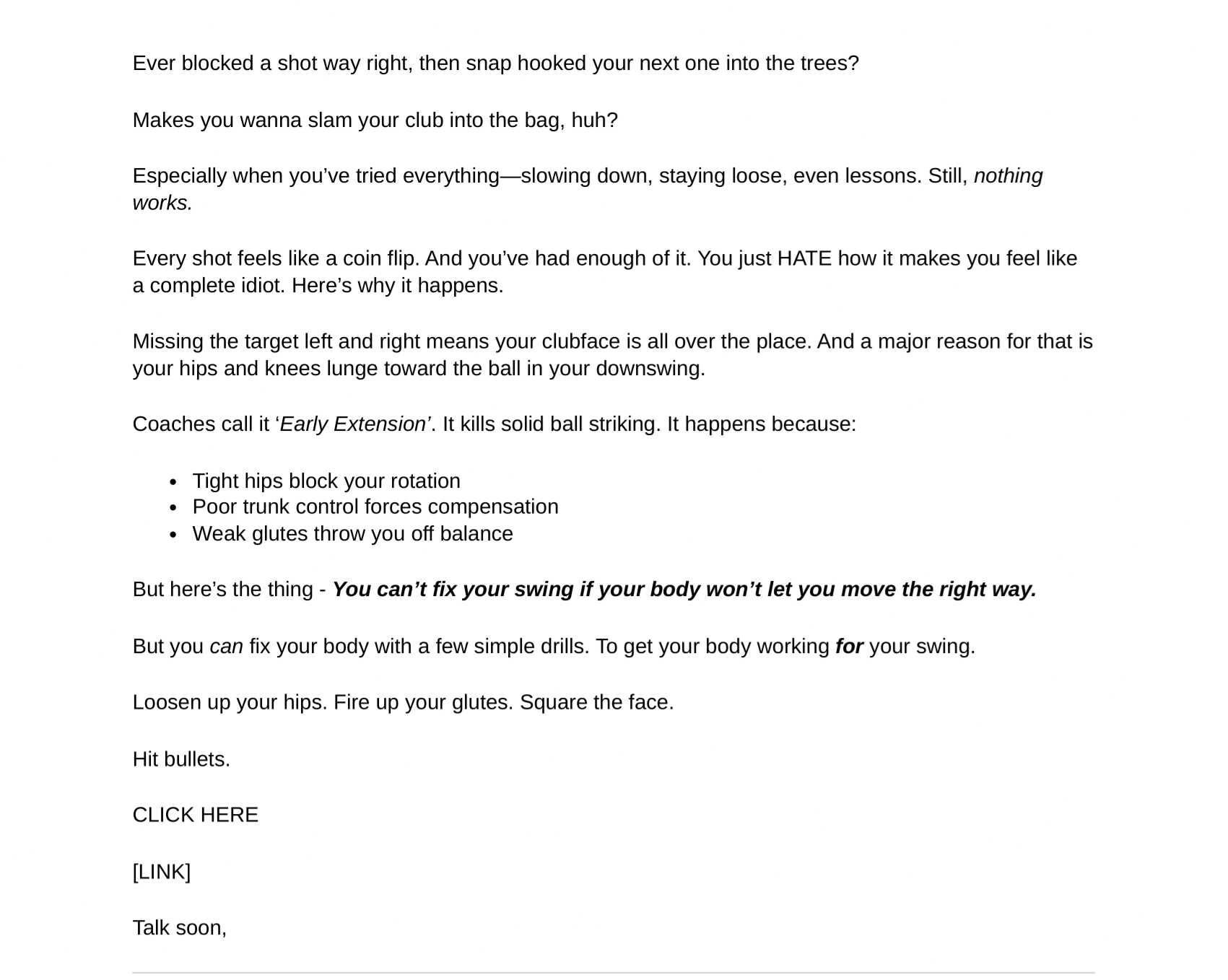
Email #4 - Eleni Kalimnios Story
This was another storytelling email to entertain and sell. It's a resilience based email to resonate with the prospects pain points, but inspire them to take action for a brighter future. My aim was to create emotional investment before I introduced the solution. I finished the email by anchoring the price to alternatives to create irresistible value. Here are my copy highlights:
- Subject line - I wrote "nagging back pain" as it's what many of the prospects have. I'm calling them right out in the first 3 words. I used "crushed" to evoke tragedy and loss, for a strong emotional pull.
- Hook - I wanted to start in the middle of action for drama and to keep people reading. Here there's conflict which resonates to an extent with the reader. Eleni is fighting minor back pain in rowing. The prospect is fighting minor back pain in Golf. There's also something at stake - Eleni wants to make it to the Olympics.
- Making the reader feel the story - by using visceral or sensory verbs like "buckled" "crashed" "gripped" it pulls the reader into the story.
- Deepening the emotional wound - I wanted to subtly remind the prospect potential consequences of not addressing their back pain. I did this through the escalation in Eleni's story - "Five months turned to five years..every stroke felt like someone jamming a knife into her spine".
- Creating irresistible value - by anchoring my clients $24 monthly subscription to a monthly chiropractor cost of $400.
Here's the email:
Subject Line: Nagging back pain crushed Eleni's world
Body:
Email #5 - Low Quality Golf Fitness Advice
It came to my attention there are fitness coaches who were dishing out advice to golfers whilst having far less knowledge than my client. Therefore the angle for this email was to provoke the prospects by suggesting their nagging pain could be due to poor advice they'd received. I'd then compare this to my client who is a Doctor of Physical Therapy to position him as uniquely qualified to advise. My approach was to make the reader feel angry to motivate action. Here are my copy highlights:
- Starting with curiosity - The line "You're only hearing half the story" sparks curiosity and makes the reader feel like they're owed something. The aim is is to get them to read the entire email.
- Real quotes seen online - by using "lift for speed!" I knew it would resonate with the prospects and make them think 'what else should I do then?'
- Establishing my clients authority - By stating my client is TPI certified and a Doctor of Physical Therapy, I'm drawing big credibility contrast with these YouTube or Instagram fitness coaches.
- Reframing the fix in line with my clients USP - As a Doctor of Physical Therapy my clients knows the science of injury prevention. So I've framed the fix as this avenue, so the solution to issues clearly lies with my client.
- Irresistible offer framing - By comparing everything they get in my clients monthly subscription to one PT session, I'm creating no brainer value.
Here's the email:
Subject Line: The fitness "advice" that's actually killing your game (and your body)
Body:
